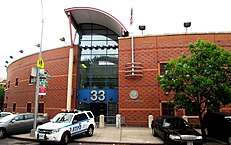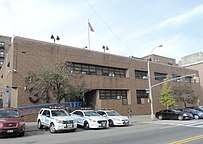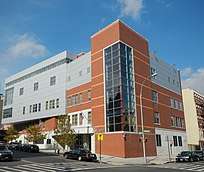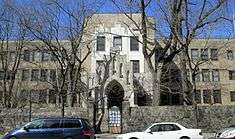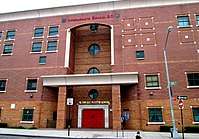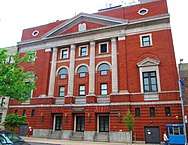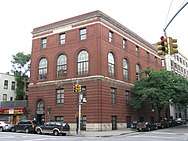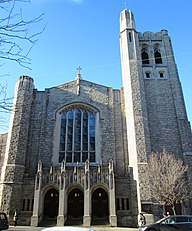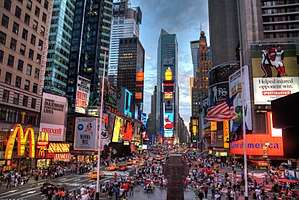Washington Heights, Manhattan
Washington Heights is a neighborhood in the northern portion of the New York City borough of Manhattan. It is named for Fort Washington, a fortification constructed at the highest natural point on Manhattan island by Continental Army troops during the American Revolutionary War, to defend the area from the British forces. Washington Heights is bordered by Inwood to the north along Dyckman Street, Harlem to the south along 155th Street, the Harlem River and Coogan's Bluff to the east, and the Hudson River to the west. As of 2016, it has a population of 201,590.
Washington Heights | |
|---|---|
Neighborhood of Manhattan | |
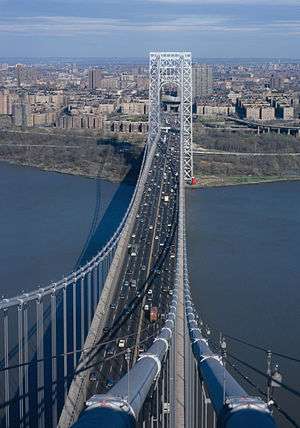 Washington Heights seen from the west tower of the George Washington Bridge, the world's busiest motor vehicle bridge.[1][2] The Little Red Lighthouse is at the base of east tower. | |
| Nickname(s): The Heights | |
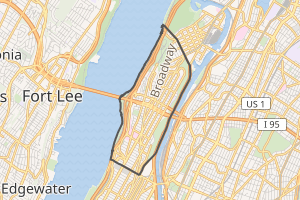
Location in New York City | |
| Coordinates: 40.84°N 73.94°W | |
| Country | |
| State | |
| City | |
| Borough | |
| Community District | Manhattan 12[3] |
| Area | |
| • Total | 4.49 km2 (1.732 sq mi) |
| Population (2016)[4] | |
| • Total | 201,590 |
| • Density | 45,000/km2 (120,000/sq mi) |
| Ethnicity | |
| • Hispanic | 70.6% |
| • White | 17.7 |
| • Black | 7.6 |
| • Asian | 2.6 |
| • Others | 2.5 |
| Economics | |
| • Median income | $45,316 |
| Time zone | UTC−5 (Eastern) |
| • Summer (DST) | UTC−4 (EDT) |
| ZIP codes | 10032, 10033, 10040 |
| Area code | 212, 332, 646, and 917 |
Washington Heights is part of Manhattan Community District 12 and its primary ZIP Codes are 10032, 10033, and 10040.[3] It is patrolled by the 33rd and 34th Precincts of the New York City Police Department.
History
Early history
_(14761757936).jpg)
Prior to the arrival of Europeans, Northern Manhattan was settled by the Weckquaesgeeks,[lower-alpha 1] a band of the Wappinger and a Lenape American Indian people.[10]:5 The winding path of Broadway north of 168th Street and St. Nicholas Avenue to its south is living evidence of the old Weckquaesgeek trail which travelled along the Hudson Valley from Lower Manhattan all the way through Albany.[11]:74[12]:442 The area was also travelled by American Indians from the Early Woodland Period,[12]:117 who left remains of shellfish and pottery at the site of the present-day Little Red Lighthouse.[11]:79
Arriving in 1623, the Dutch initially worked as trade partners with the American Indians but became more and more hostile as time went on, with the natives frequently reciprocating.[13]:20 Even after the bloody Kieft's War (1643-1645), however, some Weckquaesgeeks managed to maintain residence in Washington Heights up until the Dutch paid them a settlement for their last land claims in 1715.[8]:5
To the Dutch, the elevated area of northwestern Washington Heights was known as "Lange Berghe," meaning "Long Hill."[14] None of the land was under private ownership until 1712, when it was parcelled out in lots to various landowners from the village of Harlem to the south.[15]:745 For the greater part of the next two centuries, Washington Heights would remain a home to country estates due to lack of train access or even road network; 155th Street, for instance, was only legally opened in 1877.[8]:10[12]:3,542
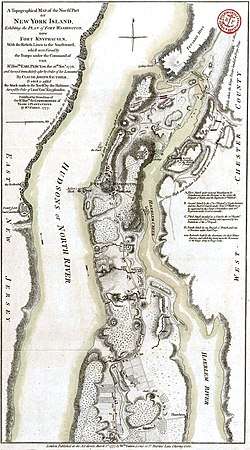
During the Revolutionary War, the battle won by the British around present-day Morningside Heights in the fall of 1776 was dubbed the Battle of Harlem Heights, referring to the contemporary name for Northern Manhattan.[8]:6[17] After their defeat in Harlem, the Continental Army was severely weakened; indeed, General George Washington wanted at first to retreat from Manhattan altogether, but was convinced to make a last stand at Fort Washington.[14][18]:111 Located around present-day Bennett Park (known then as Mount Washington),[15]:737 Fort Washington was built just a few months prior opposite Fort Lee in New Jersey in order to protect the Hudson River from enemy ships.[10]:229
Washington's soldiers were decisively defeated, with thousands killed or wounded and thousands more taken prisoner.[19]:167 Now in their control, the British eventually renamed the position Fort Tryon for Sir William Tryon,[lower-alpha 2] the last governor of New York before it was taken back by the Continental Army.[14] In contrast with its British namesake, Fort Tryon Park today holds a 1909 monument to Margaret Corbin, an American who took over at her husband's cannon after his death.[22] The plaque sits by Margaret Corbin Drive, the park's primary road which was named to honor her in 1977.[7]
Not far from the fort was the Blue Bell Tavern, located on an intersection of Kingsbridge Road, where Broadway and 181st Street intersect today, on the southeastern corner of the modern-day Hudson Heights sub-neighborhood.[23] On July 9, 1776, when New York's Provincial Congress assented to the Declaration of Independence, "A rowdy crowd of soldiers and civilians ('no decent people' were present, one witness said later) ... marched down Broadway to Bowling Green, where they toppled the statue of George III erected in 1770. The head was put on a spike at the Blue Bell Tavern ... "[23] The tavern was later used by Washington and his staff when the British evacuated New York, standing in front of it as they watched the American troops march south to retake New York.[24] Maintaining its historical significance, the site of the tavern became the Coliseum Theatre, built in 1915 but slated for demolition as of 2020, after it was denied landmark status.[25][26]
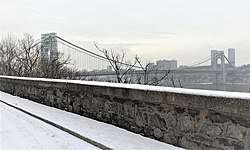
For most of the 19th century, Washington Heights was sparsely populated except for several wealthy landowners. The estate of James Gordon Bennett Sr., purchased in 1871, became Bennett Park after the City acquired it in 1928.[27] Bennett's descendants later gave the land to the city to build a park honoring the Revolutionary War encampment. Lucius Chittenden, a New Orleans merchant, built a home on land he bought in 1846 west of what is now Cabrini Boulevard and 187th Street.[28] It was known as the Chittenden estate by 1864.[24] C. P. Bucking, a sheepskin manufacturer,[29] named his home Pinehurst on land near the Hudson.[28] Both names survive today: Pinehurst Avenue stretches from 187th Street to about 176th Street between Cabrini Boulevard and Fort Washington Avenue, while Chittenden Avenue is an alley between 186th and 187th streets with a scenic view of the Hudson River, the George Washington Bridge, and the Palisades.
.jpg)
The series of ridges overlooking the Hudson held numerous villas of the time period, including the extensive property of John James Audubon along Riverside Drive. His family home was located between 155th and 156th streets just west of Riverside Drive, although it was deconstructed and moved to a city lot to make room for new development in 1931. The historic house was meant to be reconstructed eventually, yet to this day the location of its remnants is unknown.[30] Nearby Audubon's estate was Carmansville, a small village near the Hudson from about 140th Street to 158th Street, owned by wealthy landowner and box manufacturer Richard Carman.[31] The part of his estate between 153rd and 155th streets became Trinity Cemetery after he sold it to the Trinity Corporation, and the Carmansville Playground on Amsterdam Avenue between 151st and 152nd streets carries Carman's namesake to the present day.[32]
Washington Heights is also home to Fort George, a Revolutionary War encampment by the Harlem River and the last in Manhattan to be overtaken.[33] Abandoned by the British in 1783, the underlying area between 190th and 192nd streets became the Fort George Amusement Park, a trolley park/amusement park that stood from 1895 to 1914. Its site is now a seating area in Highbridge Park, which itself was laid out in the late 19th and early 20th centuries.[34]
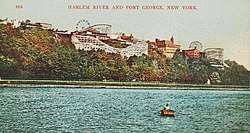
Early and mid-20th century
At the turn of the 20th century the woods started being chopped down to make way for homes. The cliffs that are now Fort Tryon Park held the mansion of Cornelius Kingsley Garrison Billings, a retired president of the Chicago Coke and Gas Company. He purchased 25 acres (100,000 m2) and constructed Tryon Hall, a Louis XIV-style home designed by Gus Lowell. It had a galleried entranceway from the Henry Hudson Parkway that was 50 feet (15 m) high and made of Maine granite.[35][36] In 1917, Billings sold the land to John D. Rockefeller Jr. for $35,000 per acre. Tryon Hall was destroyed by fire in 1925. The estate was the basis for the book "The Dragon Murder Case" by S. S. Van Dine,[37] in which detective Philo Vance had to solve a murder on the grounds of the estate, where a dragon was supposed to have lived.[24]
In the early 1900s, Irish immigrants moved to Washington Heights. Later, during the 1930s and the 1940s, European Jews settled in Washington Heights to escape Nazism.[38] Greeks started moving to Washington Heights in the 1920s, and the community was referred to as the "Astoria of Manhattan" by the 1950s and 1960s.[39] Dominican immigrants began arriving shortly after and by the 1980s, Washington Heights was the epicenter of the Dominican diaspora in the United States.[40]
Fort Tryon
During World War I, immigrants from Hungary and Poland moved in next to the Irish community.[41] Then, as Nazism grew in Germany, Jews fled. By the late 1930s, more than 20,000 refugees from Germany were living in Washington Heights.[42]
The beginning of this section of Washington Heights as a neighborhood-within-a-neighborhood seems to have started around this time, in the years before World War II. One scholar refers to the area in 1940 as "Fort Tryon" and "the Fort Tryon area." In 1989, Steven M. Lowenstein wrote, "The greatest social distance was to be found between the area in the northwest, just south of Fort Tryon Park, which was, and remains, the most prestigious section ... This difference was already remarked in 1940, continued unabated in 1970 and was still noticeable even in 1980..."[43] Lowenstein considered Fort Tryon to be the area west of Broadway, east of the Hudson, north of West 181st Street, and south of Dyckman Street, which includes Fort Tryon Park. He writes, "Within the core area of Washington Heights (between 155th Street and Dyckman Street) there was a considerable internal difference as well. The further north and west one went, the more prestigious the neighborhood..."[43]
Frankfurt-on-the-Hudson
In the years after World War II, the neighborhood was referred to as "Frankfurt-on-the-Hudson" due to the dense population of German Jews who had settled there.[44] A disproportionately large number of them had immigrated from Frankfurt-am-Main, likely giving rise to the new name.[43] No other neighborhood in the city was home to so many German Jews, who had created their own central German world in the 1930s.[45]
In 1934, members of the German-Jewish Club of New York started Aufbau, a newsletter for its members that grew into a newspaper. Its offices were nearby on Broadway.[46] The newspaper became known as a "prominent intellectual voice and a main forum for Germanic Jewry in the United States", according to the German Embassy in Washington, D.C. The paper featured the work of numerous writers and intellectuals, including Thomas Mann, Albert Einstein, Stefan Zweig, and Hannah Arendt," and was one of the few newspapers that extensively covered the terror of the Holocaust during World War II.[47]
In 1941, it published the Aufbau Almanac, a guide to living in the United States that explained the American political system, education, insurance law, the post office and sports.[48] After the war, Aufbau helped families that had been scattered by European battles to reconnect by listing survivors' names.[49] Aufbau's offices eventually moved to the Upper West Side. The paper nearly went bankrupt in 2006, but was purchased by Jewish Media AG, and exists today as a monthly news magazine. Its editorial offices are now in Berlin, but it keeps a correspondent in New York City.[50]
When the children of Jewish immigrants to the Hudson Heights area became adults, they tended to leave the neighborhood, and sometimes, the city itself. By 1960, German Jews accounted for only 16% of the population in the area.[41] The neighborhood changed in character in the 1970s as Soviet immigrants moved in. After the Soviet immigration, families from the Caribbean, especially Puerto Rico and the Dominican Republic, made it their home. So many Dominicans live in Washington Heights that candidates for the presidency of the Dominican Republic campaign in parades in the neighborhood.[51] African-Americans began to move there in the 1980s, followed shortly by other groups. Soon enough, "Frankfurt-on-the-Hudson" no longer described the neighborhood.
Late 20th and early 21st centuries
1980s crime and drug crisis
In the 1980s and early 1990s, Washington Heights was severely affected by the crack cocaine epidemic, as was the rest of New York City. Washington Heights had become the second largest drug distribution center in the Northeastern United States during that time, second only to Harlem,[52] and the neighborhood was quickly developing a reputation to that effect. Then-U.S. Attorney Rudy Giuliani and Senator Alphonse D'Amato chose the corner of 160th Street and Broadway for their widely-publicized undercover crack purchase,[53] and in 1989, The New York Times called the neighborhood "the crack capital of America."[54] By 1990, crack's devastation was evident: 103 murders were committed in the 34th Precinct that year, along with 1,130 felony assaults, 1,919 robberies, and 2,647 burglaries.[55]
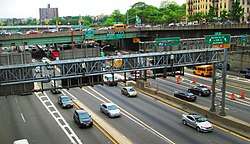
The causes behind the severity of the crisis for Washington Heights, however, were more intricate. One was the neighborhood's location: with easy access via the George Washington Bridge and its numerous highway connections, many of the customers were White suburbanites, who could easily buy cocaine while evading the shadow of violence cast upon neighborhood's residents.[56]:162 Another cause was that despite the top-level connections for the cocaine trade being Colombians, Dominicans predominantly controlled the cocaine operations in Upper Manhattan and the South Bronx, making Washington Heights especially a battleground area due to its Dominican majority.[54][57][58]
Being a drug with such high potential for profit, much of the violence of the crack crisis was a result of fierce competition for market control between numerous small crack crews, each selling their own "brands." One of the most infamous was the operation centered on 174th Street and Audubon Avenue, led by Santiago Luis Polanco Rodríguez and responsible for the "Based Balls" brand.[59]:73 Other crews identified their product by the color of the vial's top, such as the Red Top Gang, whose history is chronicled among other gangs in Robert Jackall's book Wild Cowboys: Urban Marauders & the Forces of Order.[59]
As Robert W. Snyder describes in his book Crossing Broadway: Washington Heights and the Promise of New York City, the reality of Washington Heights under the crack trade was not just one of physical danger, but also fear. People were scared to swim at the Highbridge Park pool after a thirteen-year-old was killed while she was drying off by an angry gunman who fired several rounds at a lifeguard.[56]:165 Many would keep their heads down rather than stand up to the drug dealers taking over their communities for fear of violent retribution. This was exemplified by the story of José Reyes, who organized tenants of his building on 157th Street and talked with police officers to get the Jheri Curls crack gang out of his building. Suspecting him as an informer, a Jheri Curls member shot Reyes in broad daylight after he left a local shop. Perhaps intending to avoid Reyes' fate, eyewitnesses were reluctant to describe what they saw when police arrived at the scene.[56]:178
This problem was exacerbated by the deteriorating relationship between residents and police, a conflict that came to a head on July 4, 1992, when José "Kiko" Garcia was shot by 34th Precinct Officer Michael O'Keefe on the corner of 162nd Street and Saint Nicholas Avenue. Although evidence later proved that the killing was the result of an honest conflict between an officer and a drug dealer, many residents quickly suspected police brutality.[56]:180 This sentiment was not unfounded, as O'Keefe already had several civilian complaints of unnecessary aggression in arrests.[59]:320 Furthermore, overall distrust of the police may have stemmed from corruption, which was alleged numerous times concerning the 34th Precinct overlooking drug crimes for bribes.[60] In any case, what started as a peaceful demonstration for Garcia's death turned into a violent riot, leaving broken windows, fires, fifteen injuries, and one death.[56]:181[61]
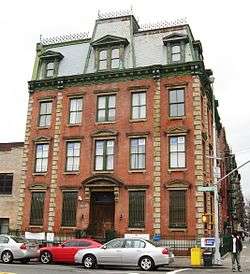
The violence of the neighborhood's drug crisis left many police officers dead as well. On October 18, 1988, 24-year-old NYPD Police Officer Michael J. Buczek was murdered by drug dealers in Washington Heights.[62] The killers fled to the Dominican Republic, where one – Daniel Mirambeaux, the alleged shooter – died in police custody in June 1989 after plunging to his death under mysterious circumstances, and a second was apprehended by U.S. Marshals in 2000. The third suspect was apprehended in the Dominican Republic in May 2002, after which Pablo Almonte, 51, and José Fernandez, 52, received maximum 25-years-to-life prison sentences for their roles in the murder of Officer Buczek.[63] As a sign of the start of a healing of relations between community members and police, the Buczek family founded the Police Officer Michael J. Buczek Foundation. Residents also named an elementary school, PS 48, in honor of Officer Buczek,[64] and the intersection of Amsterdam Avenue and Fort George Avenue in honor of his father Ted Buczek for his work in starting the Police Officer Michael J. Buczek Little League.[65] It is the nation's only program operated by police officers, hosting 30 teams with over 350 boys and girls, who are coached by officers from the NYPD and community members.[66]
Crime drop, community improvement, and gentrification
During the 1990s, Washington Heights experienced a drastic decrease in crime. This can be seen in the 2019 statistics, where the combined 33rd and 34th precinct crime rates showed dramatic reductions from the 1990 rates in motor vehicle theft (96.3% decrease), burglary (91.1%), murder (90.3%), and robbery (80.6%), while more modest reductions were made in felony assault (57.1%), rape (50%), and grand larceny (44.1%).[67][68] The 30th and 32nd precincts to the south of Washington Heights, which cover most of Harlem above 133rd Street, experienced just as drastic crime drops from 1990 to 2019. Despite this, the combined per capita crime rate of the 33rd and 34th precincts was lower than that of the Harlem precincts in 2019, with significantly lower rates of murder (50.5%), rape (49.2%), felony assault (39.2%), and robbery (37%), in addition to slightly lower rates of burglary (8.7%) and grand larceny (5.8%); the one exception was motor vehicle theft, which was 13.6% higher in the Washington Heights precincts.[69][70][71]
The crime drop, which was felt across all major cities, owed itself largely to the decrease in new users and dealers of crack cocaine, and the move of existing dealers from dealing on the streets to dealing from inside apartments.[72][73] In Washington Heights, this meant a move back to the established cocaine dealing culture that had existed before the introduction of crack. As Terry Williams notes in The Cocaine Kids: The Inside Story of a Teenage Drug Ring, many dealers from the powder cocaine era put greater emphasis on knowing their customers and hid their operations more carefully from police, as opposed to dealers of the crack days who would deal openly and fight violently in the competition for the drug's high profits.[57]
Nonetheless, many also credit actions taken on the neighborhood level in increasing safety in Washington Heights. After much advocacy from residents, in 1994 the NYPD split the 34th Precinct to create the 33rd Precinct for Washington Heights south of 179th Street, due to the concentration of the drug trade and related crimes in the area.[56]:170[74] Another local policing strategy was the "model block" initiative, first attempted in 1997 on 163rd Street between Broadway and Amsterdam Avenue, a location notable for the dealers who set up a "fortified complex" complete with traps and electrified wires to prevent police raids on their apartment.[56]:192 In an attempt to disrupt drug activity on the block, police officers set up barricades at both ends, demanded proof of residence from anyone coming through, patrolled building hallways, and pressured landlords to improve their buildings.[75] The program was controversial, facing criticism from the New York Civil Liberties Union and resistance from some residents for its invasion of privacy,[56]:193 but it did drastically reduce crime on the block,[76] and the initiative was expanded throughout the city and even exported to Chicago.[77]
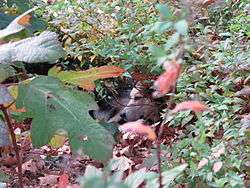
Although the improved safety was welcomed by all, violence itself was not the only outcome of the crack crisis; it also left scars on important neighborhood institutions, especially parks. Fort Tryon Park fell into a period of decline after the 1975 New York City fiscal crisis, when evaporated Parks Department funds left its walkways and playgrounds in a state of disrepair,[78] which only got worse during the crack crisis, when several corpses where found in the park.[79][80] After work from the Fort Tryon Park Trust and the New York Restoration Project throughout the 1990s and 2000s, funded by the city with the help of generous private donations,[81] the park was restored, leaving behind its reputation as a criminal area.[56]:210[78] Highbridge Park, however, had the same problems as Fort Tryon Park but went without any major restoration funding for a while, likely due to being on the poorer side of Washington Heights and lacking a frequently touristed landmark like The Cloisters.[82] In 1997, the New York Restoration Project began to work on maintaining the park, but without the necessary funding most of the park's problems continued. In 2016, however, the park received $30 million in restoration funding through the city's Anchor Parks initiative, with the full restoration set to be finished by 2020.[83][84]
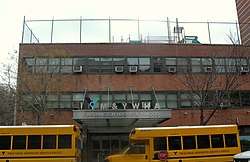
Other forms of Washington Heights' renewal came in the growth of community organizations. The arts began flourishing, most notably with groups such as the Northern Manhattan Arts Alliance and the People's Theatre Project, events such as the Uptown Arts Stroll and Quisqueya en el Hudson,[85] and the many cultural productions at the United Palace Theatre.[86][56]:208 Washington Heights also became the spotlight of major artistic achievements, most notably the Broadway musical In the Heights and the novels of Angie Cruz.[56]:219 Other organizations more focused on social services include the YM&YWHA,[87] the Washington Heights CORNER Project,[88] the Northern Manhattan Coalition for Immigrant Rights,[89] and the Community League of the Heights.[90] Two independent bookstores were also established in the 21st century: Word Up Community Bookshop on 165th Street and Amsterdam Avenue,[91] and Sisters Uptown Bookstore on 156th Street and Amsterdam Avenue,[92] both of which also serve as centers for cultural events. Evidence of the strength of the neighborhood community can be found in the 2018 Community Health Profile, which found that 80% of Community District 12 residents believe neighbors are willing to help one another, the highest in Manhattan.[93]
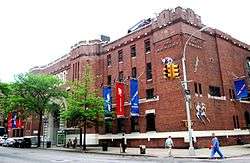
While police-community relations have certainly improved since the days of the Kiko Garcia riots, significant setbacks still exist. Police have made efforts to connect with neighborhood families through Police Athletic League programs at the Fort Washington Avenue Armory and events such as the Night Out Against Crime.[94][95] The city also chose the 33rd and 34th precincts, among two others, to start its neighborhood policing initiative in 2015, which involves assigning officers to specific neighborhood areas and alloting them time to build relationships with residents.[96][97] However, the initiative received mixed responses, with some arguing that it does not go far enough in building mutual trust and cooperation, and others fearing it as a guise for the continuation of broken windows policing.[98][99]
Washington Heights underwent substantial gentrification through the 2000s, with the 2010 Census revealing that from 2000 the neighorhood's Hispanic / Latino population had decreased by nearly 17,000 and its Black population by over 3,000, while its White population increased by nearly 5,000.[100] Data from StreetEasy also found that rents listed on its site had increased by 37% from 2000 to 2018.[101] Furthermore, there have been several high-profile cases of commercial rent increases, most notably with Coogan's, a restaurant and bar located on the corner of 169th Street and Broadway.[102] Founded in 1985, the restaurant had the legacy of a place that welcomed all, but it nearly went out of business in 2018 when its landlord NewYork–Presbyterian suddenly asked for $40,000 more in monthly rent – a move that was almost successful, despite mass opposition, if not for Adriano Espaillat, Gale Brewer, and Lin-Manuel Miranda bringing enough attention to the issue for the landlord to reconsider.[103] A similar turn of events, however, did not befall Galicia or Reme, two beloved local restaurants that had been around for decades only to be forced out by rent hikes.[104][105]
Many have expressed opposition to the neighborhood's gentrification on both commercial and residential fronts. Luis Miranda and Robert Ramirez of the Manhattan Times wrote in 2005, "How sad and ironic that many of the same people who fought to save our neighborhoods in the face of thugs and drugs have ultimately been forced to surrender their communities to the almighty dollar."[56]:206 Echoing this sentiment, Crossing Broadway author Robert W. Snyder said, "...The people who saved Washington Heights in the days of crime and crack deserve more for their pains than a stiff rent increase."[56]:237 Fears about displacement in Upper Manhattan have most recently manifest themselves in the bitter fight against the 2018 Inwood rezoning plan, which despite its offers of community benefits and affordable housing triggered fears that the luxury developments involved would accelerate ongoing gentrification.[106]
In another sign of luxury interests in the neighborhood, ground was broken in 2018 by developer Youngwoo & Associates for the Radio Tower & Hotel on Amsterdam Avenue between 180th and 181st streets. The tower, designed by MVRDV, will be a 22-story multi-use tower with office space, retail and a 221-room hotel, and is the first major mixed-use development to be built in Washington Heights in nearly five decades. Expected to be completed in 2021, it will be one of the tallest buildings in the neighborhood.[107][108]
Geography
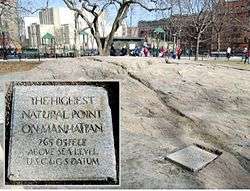
Washington Heights is on the high ridge in Upper Manhattan that rises steeply north of the narrow valley that carries 133rd Street to the former ferry landing on the Hudson River that served the village of Manhattanville. On this elevated valley is the highest terrestrial point in Manhattan, an outcropping of schist 265 feet above sea level in Bennett Park.[109]
Once considered to run as far south as 135th Street, west of Central Harlem,[110][111]:294 in the modern day Washington Heights is defined as the area from Hamilton Heights at 155th Street to Inwood at Dyckman Street.[56]:139
Sub-neighborhoods
Hudson Heights
Hudson Heights is generally considered to cover the area west of Broadway or Overlook Terrace and north of 181st Street or 179th Street,[112][113] although some extend its southern boundary as far as 173rd Street.[114][115] The name was created by neighborhood advocates who formed the Hudson Heights Owners' Coalition in 1992 to help promote the northwest part of the neighborhood.[112] Elizabeth Ritter, the president of the group, said that they "didn’t set out to change the name of the neighborhood, but [they] were careful in how [they] selected the name of the organization."[116] "Hudson Heights" actually began to be used as a name for the section of the neighborhood a year later.[117]
Hudson Heights' name has been adopted by numerous arts organizations and businesses. Newspapers such as The Wall Street Journal,[118] The New York Times,[119] and The Village Voice[120] have used the name in reference to the neighborhood, as have The New York Sun[121] and Gourmet magazine.[122] The name also has its detractors, however. Led Black of the Uptown Collective blog disparaged the name in his 2018 post titled "Hudson Heights Doesn't Exist," asserting that despite the Broadway divide, "both sides are and will forever be Washington Heights."[123] Robert W. Snyder, Manhattan Borough Historian and author of Crossing Broadway: Washington Heights and the Promise of New York City,[124] also argued that the name's intention was to "conceptually separate the area from the rest of Washington Heights," and that "use of the name could diminish a sense of shared interest on both sides of Broadway." [56]:205
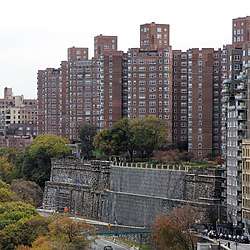
Demographically, as of the 2010 Census, nearly every census block in the area of north of 181st Street and west of Bennett Avenue is majority White, in addition to around half of the adjacent blocks between Bennett Avenue and Broadway.[100] The demographic divide between northwest Washington Heights and the rest of the neighborhood has been created by a variety of factors. One of the largest is the frequently-discussed pactice of redlining: in 1938, appraisers for the Home Owners' Loan Corporation rated only the area north of 181st Street and west of Bennett Avenue "grade A – best"; the northeast and southwest areas received "grade B – still desirable," while the area south of 181st Street and east of Broadway, of which every block was majority Black or Hispanic/Latino in 2010, received "grade C – definitely deteriorating."[56]:20[125] Another factor, seen in the greater presence of owners rather than renters in the northwest,[126] is that many rental buildings became co-ops throughout the 1970s and 80s, including the large Castle Village complex, creating a higher wealth barrier for new residents.[56]:137[127] The remaining rentals are also hard to afford: market rents are higher north of 181st Street and east of Broadway,[128] and rent-stabilized units – of which there are already fewer[129] – are disappearing more quickly, a phenomenon extending to the southwest as well.[130]
Fort George
Historically, Fort George runs from Broadway east to the Harlem River, and from West 181st Street north to Dyckman Street. The largest institution in Fort George is Yeshiva University, whose main campus sits east of Amsterdam Avenue in Highbridge Park. A branch of the Young Men's & Women's Hebrew Association is in the neighborhood, and George Washington High School sits on the site of the original Fort George. Fort George Presbyterian Church is on St. Nicholas Avenue. Fort George also holds one of Manhattan's rare semi-private streets, Washington Terrace, which runs south of West 186th Street for a half-block between Audubon and Amsterdam Avenues. The single-family homes there were built for middle-class families but some have been unoccupied for years. The M3 and M101 bus routes serve the area.[131]
Elevation changes
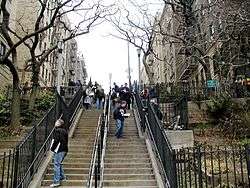
Because of their abrupt, hilly topography, pedestrian navigation in Upper Manhattan and the West Bronx is facilitated by many step streets.[132] The longest of these in Washington Heights, at approximately 130 stairs and with an elevation gain of approximately 65 feet,[133] connects Fort Washington Avenue and Overlook Terrace at 187th Street.[134]
Pedestrians can use the elevators at the 181st Street subway station, with entrances on Overlook Terrace and Fort Washington Avenue at 184th Street[135] and similarly at the 190th Street station to make the large elevation change. Only the 184th Street pedestrian connection is handicap accessible. When originally built, fare control for both of these stations was in the station house, outside the elevators, which meant that they could only be used by paying a subway fare, but both had fare control moved down to the mezzanine level in 1957, making the elevators free for neighborhood residents to use, and providing easier pedestrian connection between Hudson Heights and the rest of Washington Heights.[136] There is also a pedestrian tunnel and free elevator connection at the 191st IRT station.
Demographics
For census purposes, the New York City government classifies Washington Heights as part of two neighborhood tabulation areas called Washington Heights North and Washington Heights South, split by 181st street west of Broadway and 180th street east of Broadway.[137] Based on data from the 2010 United States Census, the population of Washington Heights was 151,574, a change of -15,554 (-10.3%) from the 167,128 counted in 2000. Covering an area of 1,058.91 acres (428.53 ha), the neighborhood had a population density of 143.1 inhabitants per acre (91,600/sq mi; 35,400/km2).[138] The racial makeup of the neighborhood was 17.7% (26,806) White, 7.6% (11,565) African American, 0.1% (180) Native American, 2.6% (4,004) Asian, 0% (15) Pacific Islander, 0.3% (517) from other races, and 1% (1,546) from two or more races. Hispanic or Latino of any race were 70.6% (106,941) of the population. While the White population is greater in Washington Heights North, the Black and Hispanic / Latino populations are greater in Washington Heights South.[5]
The most significant shifts in the racial composition of Washington Heights between 2000 and 2010 were the White population's increase by 22% (4,808), the Black population's decrease by 21% (3,024), and the Hispanic / Latino population's decrease by 14% (16,777). Both the White population's increase and the Black population's decrease were largely concentrated in Washington Heights South, while the Hispanic / Latino population's decrease was similar in both census tabulation areas. Meanwhile, the Asian population grew by 12% (412) but remained a small minority, and the small population of all other races decreased by 30% (974).[100]
The entirety of Community District 12, which comprises Washington Heights and Inwood, had 195,830 inhabitants as of NYC Health's 2018 Community Health Profile, with an average life expectancy of 81.4 years.[93]:2, 20 This is about the same as the median life expectancy of 81.2 for all New York City neighborhoods.[139]:53 (PDF p. 84) Most inhabitants are children and middle-aged adults: 33% are between the ages of 25–44, while 25% are between 45–64, and 19% are between 0–17. The ratio of college-aged and elderly residents was lower, at 10% and 13% respectively.[93]:2
As of 2017, the median household income in Community District 12 was $56,382,[140] though the median income in Washington Heights individually was $45,316.[4] In 2018, an estimated 20% of Community District 12 residents lived in poverty, compared to 14% in all of Manhattan and 20% in all of New York City. One in eight residents (12%) were unemployed, compared to 7% in Manhattan and 9% in New York City. Rent burden, or the percentage of residents who have difficulty paying their rent, is 53% in Community District 12, compared to the boroughwide and citywide rates of 45% and 51% respectively. Based on this calculation, as of 2018, Community District 12 is considered to be gentrifying: according to the Community Health Profile, the district was low-income in 1990 and has seen above-median rent growth up to 2010.[93]:7
Community
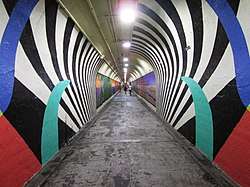
Culture
The Uptown Arts Stroll is an annual festival of the arts that highlights local artists. Public places in Washington Heights, Inwood and Marble Hill host impromptu galleries, readings, performances and markets over several weeks each summer.[141]
Bennett Park is the location of the highest natural point in Manhattan, as well as a commemoration on the west side of the park of the walls of Fort Washington, which are marked in the ground by stones with an inscription that reads: "Fort Washington Built And Defended By The American Army 1776." Land for the park was donated by James Gordon Bennett, Jr., the publisher of the New York Herald. His father, James Gordon Bennett, Sr., bought the land and was previously the Herald's publisher.[142] Bennett Park hosts an annual Harvest Festival in September and a children's Halloween Parade – with trick-or-treating afterwards – on Halloween.
In contrast to other neighborhoods in Manhattan, several of the north–south thoroughfares are mostly residential with few street-level businesses, including Fort Washington Avenue, Cabrini Boulevard, Overlook Terrace, Bennett Avenue, Sherman Avenue, and Wadsworth Avenue. However, many small shops are located on 181st Street and along Broadway, as well as St. Nicholas Avenue and Audubon Avenue.[143] Nagle Avenue, near the northern end of Washington Heights, has a YM&YWHA (Jewish Community Center) which provides numerous afterschool programs and other services to the community.[144] There is a small shopping area at 187th Street between Cabrini Boulevard and Fort Washington Avenue in the Hudson Heights sub-neighborhood. The area around New York–Presbyterian Hospital/Columbia University Medical Center has many restaurants and businesses.
One of the major annual events of Washington Heights is the Medieval Festival, a collaboration between the NYC Parks Department and the Washington Heights and Inwood Development Corporation.[145] The event is located in Fort Tryon Park, primarily on Margaret Corbin Drive from the park's entrance up to The Cloisters.[145] Typically taking place at the end of September, the event has taken place at the park since 1983.[146] The event is free, relying on a mix of private and public sponsors as well as donations. The event draws an average of 60,000 people.[147] Common attractions at the Medieval Festival include music, fencing, jousting, theatrical performances, costumes, and a variety of vendors selling Medieval-themed crafts.[148]
Ethnic makeup
Today the majority of the neighborhood, which was designated "Little Dominican Republic" along with Inwood in 2018,[149] is of Dominican birth or descent (the area is sometimes referred to as "Quisqueya Heights"), and Spanish is frequently heard spoken on the streets.[150] Washington Heights has been the most important base for Dominican accomplishment in political, non-profit, cultural, and athletic arenas in the United States since the 1980s. Most of the neighborhood businesses are locally owned.[151] As Roberto Suro describes in Strangers Among Us: Latino Lives in a Changing America, many Dominicans in Washington Heights lead double lives between the U.S. and the D.R., frequently moving between countries and often investing money back home.[152]:183 Clear evidence of how connected Washington Heights Dominicans still are with their home country is in the local protests that took place on February 22, 2020 over the postponement of elections in the Dominican Republic and the possibility of underlying corruption.[153]
Before the crash of American Airlines Flight 587 in 2001, according to an article in The Guardian, the flight had "something of a cult status in Washington Heights." A woman quoted in the newspaper said "Every Dominican in New York has either taken that flight or knows someone who has. It gets you there early. At home there are songs about it." After the crash occurred, makeshift memorials appeared in Washington Heights.[154]
Historically the home of many Irish Americans as well as German Jews, the neighborhood also has a sizable Orthodox Jewish population. In the decade leading up to 2011, the Orthodox community in Washington Heights and neighboring Inwood grew by more than 140%, from about 9,500 to nearly 24,000, the largest growth of any neighborhood identified in the Jewish Community Study, an increase largely fueled by an influx of young Orthodox Jews.[155][156]
Arts
The Audubon Mural Project paints the neighborhood with images of birds depicted by John James Audubon in his early 19th century folio The Birds of America.[157]
Heralding the arts scene north of Central Park is the annual Uptown Arts Stroll, in which artists from Washington Heights, Inwood and Marble Hill are featured in public locations throughout upper Manhattan each summer for several weeks.[141] As of 2008, the Uptown Art Stroll is run by Northern Manhattan Arts Alliance.
The Northern Manhattan Arts Alliance (NoMAA), led by Executive Director Sandra A. García Betancourt, was founded in 2007 to support artists and arts organizations in Community District 12. Their stated mission is to cultivate, support and promote the work of artists and arts organizations in Northern Manhattan. In 2008, NoMAA awarded $50,000 in grants to seven arts organizations and 33 artists in the Washington Heights/Inwood art community. NoMAA sponsors community arts events and publishes an email newsletter of all art events in Community District 12.[158]
Founded in 2008 by theater artists Mino Lora and Bob Braswell, the People's Theatre Project is an important cultural institution for youth in Northern Manhattan, and especially Washington Heights and Inwood.[159][160] The organization as a whole uses its ensemble-based theatre pieces to advocate for social justice issues. Many of their pieces, such as "Somos Más" from 2019, focus on the immigrant experience, and have toured around New York City.[161] In 2014, with funding from the US Embassy, they collaborated with Dominican youth on a piece for Santo Domingo's International Theatre Festival.[160]
Sports and leisure
Historic
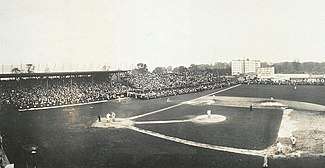
Five clubs in American professional sports played in the Washington Heights area: the New York Giants baseball club, the New York Mets, the New York Yankees, and the New York Giants and New York Jets football teams. The baseball Giants played at the Polo Grounds near 155th Street and Fredrick Douglass Boulevard from 1911–1957, the Yankees played there from 1913–1922, and the New York Mets played their first two seasons (1962 and 1963) there as well as the football Giants (1925–1955) and New York Jets (1960–1963). The Mets and Jets both began play at the Polo Grounds while their future home, Shea Stadium in Queens, was under construction.[162]
Before the Yankees played at the Polo Grounds, they played in Hilltop Park on Broadway between 165th Street and 168th Street from 1903–1912; at the time they were known as the New York Highlanders.[163] On May 15, 1912, after being heckled for several innings, the baseball great Ty Cobb leaped the fence and attacked his tormentor. He was suspended indefinitely by league president Ban Johnson, but his suspension was eventually reduced to 10 days and $50.[164] One of the most amazing pitching performances of all time took place at Hilltop Park; on September 4, 1908, 20-year-old Walter Johnson shut out New York three times in a three-game series.[165] The park is now the Columbia University Medical Center, a major hospital complex, which opened on that location in 1928.[166]
Washington Heights was the birthplace of former Yankee star Alex Rodriguez. Slugger Manny Ramírez grew up in the neighborhood, moving there from the Dominican Republic when he was 13 years old and attending George Washington High School, where he was one of the nation's top prospects. Hall-of-Fame infielder Rod Carew, a perennial batting champion in the 1970s, also grew up in Washington Heights, having emigrated with his family from Panama at the age of fourteen. The New York Yankees' Lou Gehrig grew up on 173rd Street and Amsterdam Avenue, and attended PS 132 at 185 Wadsworth Avenue; the Yankee captain lived in Washington Heights for most of his life.[167]
Modern
The New Balance Track and Field Center, located in the Fort Washington Avenue Armory, maintains an Olympic-caliber track that is one of the fastest in the world.[168] Starting in January 2012, the Millrose Games have been held there, after having been held at the second, third, and fourth Madison Square Gardens from 1914 to 2011.[169] Other activities meet at the Armory as well. High schools and colleges hold meets at the 2,300-seat auditorium at the Armory regularly, and it is open to the public for training, for a fee. Also at the Armory is the National Track and Field Hall of Fame, along with the Charles B. Rangel Technology & Learning Center for children and students in middle school and high school; the facility is operated by the Armory Foundation, which was created in 1993. The Armory is the starting point for an annual road race, the Coogan's Salsa, Blues, and Shamrocks 5K, which was founded by Peter M. Walsh, co-owner of Coogan's Restaurant.[170] The race happens in March and sanctioned by the New York Road Runners.[171]
Mountain bike races take place in Highbridge Park in the spring and summer. Sponsored by the New York City Mountain Bike Association,[172] the races are held on alternate Thursdays and are open to professional competitors and amateurs. Participating in these races is free, but the All-City Cross Country Classic requires a registration fee because prize money is awarded. The bike path along the Hudson River draws cyclists from along the West Side and elsewhere. Connection to the George Washington Bridge means Manhattan cyclists have easy access to biking up the New Jersey Palisades and northward along 9W.
Extreme swimmers take part in the Little Red Lighthouse Swim, a 5.85-mile (9.41 km) swim in the Hudson River from Clinton Cove (Pier 96) to Jeffrey's Hook, the location of the Little Red Lighthouse.[173] The annual race, sponsored by the Manhattan Island Foundation, attracts more than 200 competitors. The course records for men and women were both set in 1998. Jeffrey Jotz, then a 28-year-old from Rahway, New Jersey, finished in 1 hour, 7 minutes, and 36 seconds, while then-31-year-old Julie Walsh-Arlis, of New York, finished in 1 hour, 12 minutes, and 45 seconds.
Local politicians, sports enthusiasts, and community organizers have organized the "Uptown Games" for children at the Fort Washington Avenue Armory.[174] The event has an aim of "teaching kids at an early age what a pleasure it is to be physically active", according to one of the 2012 organizers, Cliff Sperber, of the New York Road Runners Association.[175]
Points of interest

Parks
Washington Heights has some of the largest parks in northern Manhattan, which collectively has over 500 acres (200 ha) of parkland.[176]
- Fort Tryon Park – home of The Cloisters[177]
- Highbridge Park – home of the Highbridge Pool and Water Tower[178]
- Fort Washington Park – home of the Little Red Lighthouse[179]
- Bennett Park – location of the highest natural point in Manhattan[142]
- Mitchel Square Park – site of the Washington Heights and Inwood World War I memorial by Gertrude Vanderbilt Whitney[180]
- J. Hood Wright Park[181]
- Amelia Gorman Park[182]
- McKenna Square[183]
Landmarks and attractions
Among the Heights' now-vanished riverfront estates was "Minnie's Land", the home of ornithological artist John James Audubon, who is buried in Trinity Church Cemetery churchyard of the neighborhood's Church of the Intercession (1915), a masterpiece by architect Bertram Goodhue. Also buried there is poet Clement Clarke Moore, who wrote "'Twas the Night Before Christmas".[184]
Columbia-Presbyterian, the first academic medical center in the United States, opened in 1928.[185] Now known as NewYork-Presbyterian / Columbia University Irving Medical Center and Columbia University College of Physicians and Surgeons, the medical school of Columbia University, lie in the area of 168th Street and Broadway, occupying the former site of Hilltop Park, the home of the New York Highlanders – now known as the New York Yankees – from 1903 to 1912.[186] Across the street is the New Balance Track and Field Center, an indoor track and home to the National Track & Field Hall of Fame.[187]
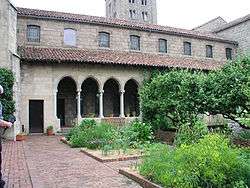
A popular cultural site and tourist attraction in Washington Heights is The Cloisters in Fort Tryon Park at the northern end of the neighborhood, with views across the Hudson to the New Jersey Palisades.[177] This branch of the Metropolitan Museum of Art is devoted to Medieval art and culture, and is located in a medieval-style building, portions of which were purchased in Europe by John D. Rockefeller Jr. in 1925, brought to the United States, and reassembled, opening to the public in 1938.[188]
Audubon Terrace, a cluster of five distinguished Beaux Arts institutional buildings, is home to another major, though little-visited museum, The Hispanic Society of America.[189] The Society has the largest collection of works by El Greco and Goya outside the Museo del Prado, including one of Goya's famous paintings of Cayetana, Duchess of Alba. In September 2007, it commenced a three-year collaboration with the Dia Art Foundation. The campus on Broadway at West 156th Street also houses The American Academy of Arts and Letters, which holds twice yearly, month-long public exhibitions, and Boricua College.

Manhattan's oldest remaining house, the Morris–Jumel Mansion, is located in the landmarked Jumel Terrace Historic District, between West 160th and West 162nd Street, just east of St. Nicholas Avenue. An AAM-accredited historic house museum, the Mansion interprets the colonial era, the period when General George Washington occupied it during the American Revolutionary War, and the early 19th century in New York.[190]
The Paul Robeson Home, located at 555 Edgecombe Avenue on the corner of Edgecombe Avenue and 160th Street, is a National Historic Landmark building. The building is known for its famous African American residents including actor Paul Robeson, musician Count Basie, and boxer Joe Louis.[191]
Other notable Washington Heights residents include Althea Gibson the first African American Wimbledon Champion, Frankie Lymon of "Why Do Fools Fall in Love?" fame, Leslie Uggams who was a regular on the Sing Along with Mitch Show. Other musicians who resided in the area for significant periods of time were jazz drummers Tony Williams and Alphonse Muzon and Grammy award-winning Guitarist Marlon Graves.
On February 21, 1965, Malcolm X was assassinated during a speech at the Audubon Ballroom, on Broadway at West 165th Street. The interior of the building was demolished, but the Broadway facade remains, incorporated into one of Columbia's Audubon Center buildings. It is now the home of the Malcolm X and Dr. Betty Shabazz Memorial and Educational Center.[192] Several shops, restaurants and a bookstore occupy the first floor.
At the Hudson's shore, in Fort Washington Park[193] stands the Little Red Lighthouse, a small lighthouse located at the tip of Jeffrey's Hook at the base of the eastern pier of the George Washington Bridge that was made famous by a 1942 children's book.[179] It is the site of a namesake festival in the late summer. A 5.85-mile (9.41 km) recreational swim finishes there in early autumn.[194] It's also a popular place to watch for peregrine falcons.[195]
The United Palace, made a landmark in 2016, hosts a number of cultural and performing arts.[196] Originally a theater, it was bought by Reverend Ike and became a church for the United Church Science of Living Institute.[197]
Local newspaper
Manhattan Times is a free English / Spanish bilingual community newspaper serving Upper Manhattan, with a focus on Washington Heights and Inwood. It was founded by Luís A. Miranda Jr., Roberto Ramírez Sr., and David Keisman in 2000.[198] The print version is distributed on Wednesdays to 235 different street boxes and community organizations (as of March 2020), with over 120 locations in Washington Heights.[199]
The newspaper covers a variety of topics of local interest, and has played a role in promoting local restaurants, real estate, and local events alike. The newspaper has also backed many community projects such as the Bridge / Puente project in May 2006, where residents and local politicians stood together along the entire length of Dyckman Street, and the Uptown Arts Stroll, a highlight of local artists.[200]
Police and crime
Washington Heights is served by two precincts of the NYPD.[201] The area north of 179th Street is served by 34th Precinct along with Inwood, located at 4295 Broadway,[55] while the area south of 179th Street is served by the 33rd Precinct, located at 2207 Amsterdam Avenue.[202] The precincts were split in 1994 in order to increase the amount of police presence in Washington Heights, due to the high crime rate at the time, but crime has fallen drastically since then.[203][204]
The 34th Precinct saw 6 murders, 22 rapes, 226 robberies, 283 felony assaults, 122 burglaries, 557 grand larcenies, and 62 grand larcenies auto in 2019. Crime in these categories fell by 80.6% in the precinct between 1990 and 2019, and by 42.0% in the precinct since 1998, four years after the 33rd and 34th precincts were split.[68] Of the five major violent felonies (murder, rape, felony assault, robbery, and burglary), the 34th Precinct had a rate of 583 crimes per 100,000 residents in 2019, compared to the boroughwide average of 632 per 100,000 and the citywide average of 572 per 100,000.[69][205][206]
The 33rd Precinct saw 4 murders, 11 rapes, 146 robberies, 202 felony assaults, 114 burglaries, 264 grand larcenies, and 38 grand larcenies auto in 2019. Crime in these categories fell by 53.2% between 1998 and 2019, and by 35.5% between 2001 and 2019.[67] Of the five major violent felonies (murder, rape, felony assault, robbery, and burglary), the 33rd Precinct had a rate of 620 crimes per 100,000 residents in 2019, compared to the boroughwide average of 632 per 100,000 and the citywide average of 572 per 100,000.[69][205][206]
As of 2018, Community District 12 has a non-fatal assault hospitalization rate of 43 per 100,000 people, compared to the boroughwide rate of 49 per 100,000 and the citywide rate of 59 per 100,000. Its incarceration rate is 482 per 100,000 people, compared to the boroughwide rate of 407 per 100,000 and the citywide rate of 425 per 100,000.[93]:8
In 2019, the highest concentrations of felony assaults in Washington Heights were on 168th Street between Broadway and Fort Washington Avenue, where there were 17, and near the intersection of 178th Street and Broadway, where there were 14. The highest concentrations of robberies, on the other hand, were near the intersection of 181st Street and Saint Nicholas Avenue, where there were 9, and on 155th Street between Saint Nicholas Avenue and Amsterdam Avenue, where there were also 9.[69]
Fire safety
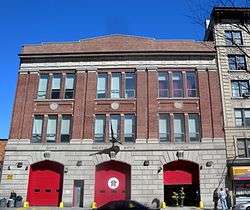
Washington Heights is served by three New York City Fire Department (FDNY) fire stations:[207]
- Engine Co. 67 – 518 West 170th Street[208]
- Engine Co. 84/Ladder Co. 34 – 513 West 161st Street[209]
- Engine Co. 93/Ladder Co. 45/Battalion 13 – 515 West 181st Street[210]
In addition, FDNY EMS Station 13 is located at 501 West 172nd Street.[211]
Health
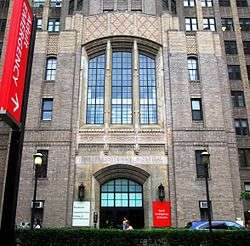
Preterm births in Manhattan Community District 12 are lower than the city average, though teenage births are higher. In Community District 12, there were 73 preterm births per 1,000 live births (compared to 87 per 1,000 citywide), and 23.3 teenage births per 1,000 live births (compared to 19.3 per 1,000 citywide).[93]:11 Community District 12 has a low population of residents who are uninsured. In 2018, this population of uninsured residents was estimated to be 14%, compared to the 12% of residents citywide.[93]:14
The concentration of fine particulate matter, the deadliest type of air pollutant, in Community District 12 is 0.0078 milligrams per cubic metre (7.8×10−9 oz/cu ft), slightly greater than the city average of 7.5.[93]:9 Thirteen percent of Community District 12 residents are smokers, similar to the city average of 14%.[93]:13 In Community District 12, 26% of residents are obese, 13% are diabetic, and 28% have high blood pressure—compared to the citywide averages of 24%, 11%, and 28% respectively.[93]:16 Additionally, 24% of children are obese, more the citywide average of 20%.[93]:12
Eighty-one percent of residents eat some fruits and vegetables every day, less than the citywide average of 87%. In 2018, 68% of residents described their health as "good," "very good," or "excellent," also less than the citywide average of 78%.[93]:13 For every supermarket in Community District 12, there are 13 bodegas.[93]:10
The overall life expectancy of Community District 12 is 84, 2.8 years greater than the citywide average.[93]:20 This is likely because its rates of premature death from cancer (39.1 per 100,000), heart disease (26.1 per 100,000), and accidents (5.6 per 100,000) were significantly lower than thr citywide rates, although the drug-related death rate (9.6 per 100,000) was similar and the suicide death rate (7.2 per 100,000) was higher.[93]:18
The NewYork–Presbyterian Hospital / Columbia University Medical Center is located in Washington Heights at 168th Street between Broadway and Fort Washington Avenue. Built and opened in the 1920s, and known as the Columbia–Presbyterian Medical Center until 1998, the complex was the world's first academic medical center. The campus contains the Columbia University College of Physicians and Surgeons, the medical school of Columbia University. The campus also contains Morgan Stanley Children's Hospital, New York City's only stand-alone children's hospital. In addition, NewYork–Presbyterian's Allen Hospital is located in Inwood.[212][213]
Post offices and ZIP codes
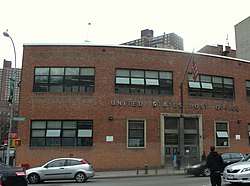
Washington Heights is located in three ZIP Codes. From south to north, they are 10032 (between 155th and 173rd streets), 10033 (between 173rd and 187th streets) and 10040 (between 187th and Dyckman streets).[214] The United States Postal Service operates three post offices near Washington Heights:
Education
Community District 12 generally has fewer college graduates and more high school dropouts than the borough and city as a whole. While 38% of residents age 25 and older have a college education or higher, 33% are high school graduates or have some college education, and 29% have less than a high school education. In contrast, 64% of Manhattan residents and 43% of city residents have a college education or higher, and the boroughwide and citywide high school dropout rates are 13% and 19%, respectively.[93]:6
From 2013 to 2019, the average percentage of District 6 students to get a 3 or 4 on the ELA State Test rose from 14.3% to 39.4%. The Math State Test saw a similar increase, from 17.0% to 38.4%. Despite this growth, test scores were starkly divided by race, with the 2019 ELA pass rate being 72.7% for White students, 64.2% for Asian students, 36.7% for Hispanic / Latino students, and 35.2% for Black students. The Math pass rates were similarly divided, being 72.6% for White students, 66.9% for Asian students, 35.9% for Hispanic / Latino students, and 31.8% for Black students.[219][220]
Community District 12's rate of elementary student absenteeism is similar to the rest of New York City. As of 2018, 19% of elementary school students missed twenty or more days per school year, about the same as the boroughwide average of 18% and the citywide average of 20%.[139]:24 (PDF p. 55)[93]:6 Additionally, 68% of public high school students in Community District 12 graduate in four years, less than the boroughwide average of 73% and the citywide average of 75%.[93]:6
Schools
Public schools
Public primary and secondary schools are provided to New York City students by the New York City Department of Education. Washington Heights is part of District 6, along with Inwood and parts of Hamilton Heights.
Zoned public elementary and elementary/middle schools include:
- PS 189 (grades 3K-5)[221]
- PS 48 Police Officer Michael John Buczek (grades 3K-5)[222]
- PS 128 Audubon (grades 3K-5)[223]
- PS 132 Juan Pablo Duarte (grades K-5)[224]
- PS 173 (grades 3K-5)[225]
- PS 115 Alexander Humboldt (grades PK-5)[226]
- PS/IS 187 Hudson Cliffs (grades PK-8)[227]
- PS 192 Jacob H. Schiff (grades 3K-5)[228]
- PS 4 Duke Ellington (grades 3K-5)[229]
- PS 8 Luis Belliard (grades 3K-5)[230]
- Dos Puentes Elementary School (grades K-5)[231]
- PS 28 Wright Brothers (grades 3K-5)[232]
Unzoned elementary and elementary/middle schools include:
- Castle Bridge School (grades PK-5)[233]
- PS 178 Professor Juan Bosch (grades K-5)[234]
- Washington Heights Academy (grades PK-8)[235]
Zoned middle schools include:
- JHS 143 Eleanor Roosevelt (grades 6-8)[236]
- MS 319 Maria Teresa (grades 6-8)[237]
- MS 324 Patria Mirabal (grades 6-8)[238]
Unzoned middle and middle/high schools include:
- Harbor Heights Middle School (grades 6-8)[239]
- Community Health Academy of the Heights (grades 6-12)[240]
- Community Math and Science Prep (grades 6-8)[241]
- IS 528 Bea Fuller Rodgers (grades 6-8)[242]
- City College Academy of the Arts (grades 6-12)[243]
The former George Washington High School, built in 1923, takes up an entire block between Audubon and Amsterdam Avenues, stretching slightly past West 192nd and 193rd streets. It became the George Washington Educational Campus in 1999 when it was split into four smaller schools:[244]
- The College Academy (grades 9-12)[245]
- High School for Media and Communications (grades 9-12)[246]
- High School for Law and Public Service (grades 9-12)[247]
- High School for Health Careers and Sciences (grades 9-12)[248]
The Gregorio Luperón High School for Science and Mathematics was founded in 1994 and serves students who have lived in the United States for two years or fewer and speak Spanish at home. It is located on the corner of 165th Street and Amsterdam Avenue.[249][250]
Washington Heights also has the unzoned Washington Heights Expeditionary Learning School, on 182nd Street between Amsterdam Avenue and Audubon Avenue. It was founded in 2006 and is now an elementary, middle, and high school, serving grades PK to 12.[251][252]
Charter and private schools
Success Academy Charter Schools has a location, serving grades K to 4, in the former Mother Cabrini High School building near Fort Tryon Park.[253] KIPP also has a location between Jumel Place and Edgecombe Avenue in the Mirabal Sisters Campus, serving grades K to 8.[254]
The independent WHIN Community Charter School serves grades K to 3 and in the Mirabal Sisters Campus on Edgecombe Avenue between 164th Street and 165th Street.[255] The School in the Square is another Washington Heights charter school, serving grades 6 to 8 and located on the corner of 179th Street and Wadsworth Avenue.[256]
Private schools include:
- Incarnation School (grades 3K-8)[257]
- Saint Elizabeth School (grades 3K-8)[258]
- Yeshiva Rabbi Samson Raphael Hirsch (grades 3K, PK, and 1-12)[259]
- Marsha Stern Talmudical Academy (grades 9-12)[260]
- Birch Family Services' Washington Heights Education Center (ages 3-8)[261]
- Medical Center Nursery School (ages 2-5)[262]
- Renaissance Village Montessori School (ages 1-6)[263]
- Gardens Daycare (pre-PK)[264]
- Bright Horizons at New York Presbytarian Hospital (ages 1-5)[265]
Higher education
University education in Washington Heights includes Yeshiva University[266] and the primary campus of Boricua College.[267] The medical campus of Columbia University hosts the College of Physicians and Surgeons, the College of Dental Medicine, the Mailman School of Public Health, the School of Nursing, and the biomedical programs of the Graduate School of Arts and Sciences, which offer Masters and Doctorate degrees in several fields.[268] These schools are among the departments that compose the Columbia University Irving Medical Center.[269]
CUNY in the Heights, a program of the Borough of Manhattan Community College of the City University of New York, is actually located in Inwood, on the corner of 213th Street and Broadway, despite its name.[270] The CUNY XPress Immigration Center is located in the same building; its purpose is to assist immigrants and to help students enroll in one of the CUNY schools.[271]
Libraries
The New York Public Library (NYPL) operates two branches in Washington Heights:
- The Fort Washington branch is located at 535 West 179th Street. The three-story Carnegie library opened in 1979.[272]
- The Washington Heights branch is located at 1000 St. Nicholas Avenue. It was founded in 1868 and moved to two separate buildings before relocating to its current structure in 1914.[273]
Religious institutions
Christian institutions include:
- Church of the Incarnation (Roman Catholic)[274]
- Holy Cross Armenian Apostolic Church (Armenian Apostolic Church)[275]
- Saint Rose Of Lima Church (Roman Catholic)[276]
- St. Spyridon Greek Orthodox Church[277]
- Saint Elizabeth Church (Roman Catholic)[278]
- Fort Washington Collegiate Church[279]
- Our Saviour's Atonement Lutheran Church (ELCA)[280]
- Holyrood Episcopal Church[281]
- Our Lady Queen of Martyrs Church (Roman Catholic)[282]
- Fort Washington Presbyterian Church – Iglesia Presbiteriana Fort Washington Heights[283]
- Fort Washington Iglesia Adventista del Séptimo Día – Fort Washington Seventh-Day Adventist Church[284]
- Our Lady of Esperanza Church (Roman Catholic)[285]
- Iglesia Pentecostal Monte Calvario – Monte Calvario Pentecostal Church[286]
- Paradise Baptist Church[287]
- AME Zion Church on the Hill (African Methodist Episcopal Zion)[288]
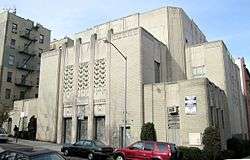
Jewish institutions include:
- Yeshiva University's Wilf Campus[289]
- Fort Tryon Jewish Center (Unaffiliated)[290]
- Hebrew Tabernacle Congregation (Reform)[291]
- K'hal Adath Jeshurun (Orthodox)[292]
- Mount Sinai Jewish Center (Modern Orthodox)[293]
- Shaare Hatikvah Congregation (Orthodox)[294]
- Washington Heights Congregation: The Bridge Shul (Modern Orthodox)[295]
Washington Heights also has one Muslim institution, the Al-Rahman Mosque, on the corner of 175th Street and St. Nicholas Avenue.[296]
Transportation
Bridges and highways
Washington Heights is connected to Fort Lee, New Jersey across the Hudson River via the Othmar Ammann-designed George Washington Bridge, the world's busiest motor vehicle bridge.[1][2] The Pier Luigi Nervi-designed George Washington Bridge Bus Terminal is located at the Manhattan end of the bridge, at 179th Street and Fort Washington Avenue.[297] In 1963, the year it was built, Nervi won an award for the terminal's use of concrete.[298] One of its most unique features is the huge ventilation ducts that look like concrete butterflies from a distance.[299]
The Trans-Manhattan Expressway, a portion of Interstate 95, proceeds for 0.8 miles (1.3 km) from the George Washington Bridge in a trench between 178th and 179th streets.[300] To the east, the highway leads to the Alexander Hamilton Bridge, completed in 1963 across the Harlem River to connect the GWB to the Bronx and the Cross Bronx Expressway.[301] The Washington Bridge crosses the Harlem River just north of the Alexander Hamilton Bridge. The High Bridge is the oldest bridge in New York City still in existence, crossing the river just south of the Alexander Hamilton Bridge at 175th Street in Manhattan. Completed in 1848, it originally carried the Croton Aqueduct as part of the New York City water system and later functioned as a pedestrian bridge that had been closed to the public since the 1970s.[302] In the late 1920s, several of the stone piers were replaced with a steel arch that spanned the river to allow ships to more easily navigate under the bridge.[303] In June 2015 the High Bridge reopened as a pedestrian and bicycle bridge.[302]
The Henry Hudson Parkway, part of New York State Route 9A, runs near the Hudson River, cutting directly through Fort Tryon and Fort Washington parks on the western edge of Washington Heights.[304] The highway was originally envisioned to run on the eastern edge of the parkland, but then-NYC Parks Commisioner Robert Moses opted for the current route in order to save funds that would be needed to buy the parkside land, and to get extra money for the project from the Civil Works Administration that was contingent on the highway being a "park access road."[305]:534 This arrangement cut left the western edge of both parks cut off from direct access from residential areas, except through the Hudson River Greenway.
Subway
Washington Heights is well served by the New York City Subway. On the IND Eighth Avenue Line, service is available at the 155th Street and 163rd Street–Amsterdam Avenue stations (C train), the 168th Street station (1, A, and C trains), and the 175th Street, 181st Street, and 190th Street stations (A train). The IRT Broadway–Seventh Avenue Line (1 train) has stops at 157th Street, 168th Street, 181st Street, and 191st Street.[306]
The 190th Street station contains the subway's only entrance in the Gothic style,[307] although when originally built, it was a plain brick building; the stone facade was added later to bring the building into harmony with the entrance to Fort Tryon Park just across Margaret Corbin Circle.[136] The station was listed on the National Register of Historic Places in 2005.[308] The 190th Street and 191st Street stations have the distinction of being the deepest in the entire subway system by distance to ground level.[309] Because of this, the IND 181st Street and 190th Street stations provide elevator connections between the Hudson Heights subneighborhood, on the top of the ridge, and the Broadway valley of Washington Heights below.[310] The IRT 191st Street station also has elevators to street level and a passageway to the Broadway valley.[311]
.jpg) 163rd Street station, with a mural commissioned from Firelei Báez in 2018.[312]
163rd Street station, with a mural commissioned from Firelei Báez in 2018.[312]- 168th Street IRT Station
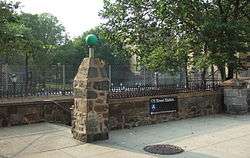 Entrance to the 175th Street station at 175th St. and Ft. Washington Avenue
Entrance to the 175th Street station at 175th St. and Ft. Washington Avenue- Entrance to the 181st Street IND station at 184th Street and Ft. Washington Avenue
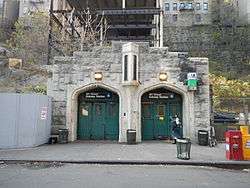 Other entrance to the 181st Street IND station on Overlook Terrace at 184th Street
Other entrance to the 181st Street IND station on Overlook Terrace at 184th Street Entrance to 190th Street station on Bennett Avenue
Entrance to 190th Street station on Bennett Avenue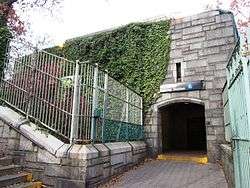 Other entrance to 190th Street station on Ft. Washington Avenue, near Fort Tryon Park
Other entrance to 190th Street station on Ft. Washington Avenue, near Fort Tryon Park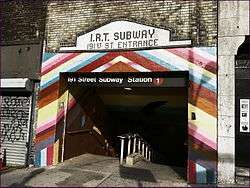 Entrance to the 191st Street station at 191st Street and Broadway
Entrance to the 191st Street station at 191st Street and Broadway
Bus
The following MTA Regional Bus Operations bus routes serve Washington Heights:[131][313]
|
|
In popular culture
- The ABC soap opera Ryan's Hope was set in Washington Heights and aired on ABC from 1975 to 1989.[314]
- In the 1941 film Citizen Kane, Jedidiah Leland is spending the remainder of his life in the fictitious "Huntington Memorial Hospital" on 180th Street.[315]
- Parts of the 2010 film Salt were filmed in the neighborhood, in particular at the 12-story Riviera, a 1910 Beaux-Arts style co-op on 157th Street and Riverside Drive.[316]
- The final scene from the 1948 film Force of Evil, where Joe Morse discovers the body of his brother near the Hudson River, was filmed on location in the park several yards south of the George Washington Bridge.[317]
- The musical In the Heights, which ran on Broadway from 2008 to 2011, is set in Washington Heights.[318] Its upcoming film adaptation was shot in many Washington Heights locations, including the 191st Street station tunnel.[319]
- CSI: NY Season 2 Episode 16 ("Cool Hunter") features a case of a dead man in a Washington Heights playground.[320]
- The 2008 film Pride and Glory centers on police corruption in the fictional 31st Precinct of Washington Heights.[321]
- The 2005 documentary Mad Hot Ballroom features students from PS 115 in Washington Heights.[322]
- Scenes from the 1995 film Die Hard with a Vengeance were also shot at PS 115.[323]
- The 1993 film The Saint of Fort Washington is not entirely geographically accurate, but is set in the neighborhood, with the Fort Washington Avenue Armory in particular playing a large role in the plot.[324]
- The song "Halloween Parade" by Lou Reed mentions a "crack team from Washington Heights."[325]
- The 1968 film Coogan's Bluff features a scene where Clint Eastwood chases the criminal he is to bring back to Arizona through the Cloisters.[326]
- The 1953 film How to Marry a Millionaire features the George Washington Bridge entering into Washington Heights when Waldo Brewster, a grumpy businessman (Fred Clark), and Loco Dempsey (Betty Grable), driving back into Manhattan from the "Elks Lodge", are pulled over by motorcycle cops so the bridge commission can recognize "the lucky couple" as the occupants of the bridge's 50 millionth vehicle.[327][328]
- The 2002 film Washington Heights starring Manny Perez is the story of a young man trying to escape the cultural barriers of Washington Heights to make it as an illustrator.[329]
- The MTV series Washington Heights, which did not continue beyond 2013, is set in the neighborhood.[330]
- The 2007 film The Brave One, with Jodie Foster, was filmed in some sections of Washington Heights; she and her boyfriend are attacked in a scene filmed in Fort Tryon Park, and the final scene with Terrence Howard was filmed on Elwood Street between Broadway and Nagle Avenue.[331]
- The 2005 film Get Rich or Die Tryin', with rapper/actor Curtis Jackson, includes scenes filmed in Washington Heights, including scenes that featured "young 50 Cent" filmed around 159th Street and Riverside Drive.
- In the song "Broadway Baby" from the musical Follies, aging chorus girl Hattie wishes she could be a star all over Manhattan, "from Battery Park to Washington Heights!"[332]
- In the song "Shiksa Goddess" from the musical The Last Five Years, Jewish romantic lead Jamie Wellerstein states that he had "Shabbas dinners on Friday nights with every Shapiro in Washington Heights!"[333]
- The song "This Is Why I'm Hot" by MIMS has the line "I hit Wash Heights with the money in the bag".[334]
- The song "A-Punk" by the band Vampire Weekend mentions Washington Heights.[335]
- The Showtime series Weeds features Washington Heights as the location of Nancy Botwin's halfway house in Season 7.[336]
- The 2007 film American Gangster was filmed in some sections of Washington Heights.[337]
- The 2013 film Frances Ha ends with the main character moving to Washington Heights.[338]
- The HBO series The Deuce chose Amsterdam Avenue between 163rd and 165th streets to recreate Times Square, mostly because of its dimensional similarities, quiet atmosphere, and lack of trees, scaffolding, or chains.[339]
- The upcoming film remake of West Side Story was filmed in Washington Heights under the work title "San Juan Hill."[340][341]
- The song "The Movement" by KRS-One has the lyric "I'm in Washington Heights, puttin' them Dominicans on."[342]
Notable people
Notable current and former residents of Washington Heights include:
- Pedro Alvarez (born 1987), baseball player who was drafted second overall by the Pittsburgh Pirates in the 2008 Major League Baseball Draft.[343]
- Alex Arias (born 1967), Dominican-American former Major League Baseball player.[344]
- George Grey Barnard (1863–1938), sculptor.[345]
- Harry Belafonte (born 1927), calypso singer and Grammy winner.[346]
- Ward Bennett (1917–2003), designer, artist and sculptor.[347]
- Dellin Betances (born 1988), MLB pitcher for the New York Mets.[348]
- Jocelyn Bioh, Ghanaian-American writer, playwright and actor.[349]
- Carl Blaze (1976–2006), Hip-Hop/R&B DJ for Power 105.1.[350]
- Stanley Bosworth (1927–2011), founding headmaster of Saint Ann's School in Brooklyn, which he headed from 1965 to 2004.[351]
- Tally Brown (1934–1989), singer and actress in films by Andy Warhol and other underground filmmakers.[352]
- Robert John Burke (born 1960), actor.[353]
- Maria Callas (1923–1977), opera singer, was raised in Washington Heights until she was 14. Her school certificate hangs in the hallways of P.S. 132.[354]
- Jerry Craft (born 1963), children's book author and illustrator / syndicated cartoonist and creator of the Mama's Boyz comic strip.[355]
- Cardi B (born 1992), rapper, songwriter, actress and television personality.[356]
- Rod Carew (born 1945), former professional baseball player.[357]
- Frances Conroy (born 1953), actress.[112]
- Nelson Antonio Denis (born 1954), former member of the New York State Assembly.[358]
- Morton Deutsch (1920-2017), social psychologist who was one of the founding fathers of the field of conflict resolution.[359]
- David Dinkins (born 1927), Mayor of New York City 1990–1994.[360]
- Jim Dwyer (born 1957), columnist and reporter at The New York Times.[361]
- Laurence Fishburne (born 1961), Academy Award-nominated actor.[362]
- Luis Flores (born 1981), former NBA point guard.[363]
- Hillel Furstenberg (born 1935), mathematician known for his application of probability theory and ergodic theory methods to other areas of mathematics.[364]
- Lou Gehrig (1903–1941), professional baseball player for the New York Yankees.[365]
- Elias Goldberg (1886–1978), New York painter, most of his city paintings focus on the area of Washington Heights. Mr. Goldberg exhibited at the legendary Charles Egan Gallery.[366]
- David Gorcey (1921–1984), brother of Leo and regular member of the Dead End Kids / East Side Kids / The Bowery Boys.[367]
- Leo Gorcey (1917–1969), member of the original cast of "Dead End", and memorably outspoken member of the Dead End Kids / East Side Kids / The Bowery Boys.[368]
- Alan Greenspan (born 1926), 13th Chairman of the Board of Governors of the Federal Reserve.[369]
- Hex Hector (born 1965), Grammy Award-winning remixer and producer.[370]
- Jacob K. Javits (1904–1986), United States Senator from 1957 to 1981.[371]
- Henry Kissinger (born 1923), former National Security Advisor and United States Secretary of State.[372]
- Paul Kolton (1923–2010), chairman of the American Stock Exchange.[373]
- Joshua Lederberg (1925–2008), geneticist who received the 1958 Nobel Prize in Physiology or Medicine for work in bacterial genetics, was born in Montclair.[374][375]
- Stan Lee (1922-2018), Creator of Spider-Man, X-Men, The Incredible Hulk.[376]
- Lin-Manuel Miranda (born 1980), actor, and Tony Award-winning composer, and lyricist, best known for writing and acting in the Broadway musicals In the Heights and Hamilton.[377]
- Daniel D. McCracken (1930–2011), early computer pioneer and author.[378]
- Theodore Edgar McCarrick (born 1930), Cardinal who served as Roman Catholic Archdiocese of Washington (2001–2006).[379]
- Knox Martin (born 1923), painter, sculptor and muralist.[380]
- Mims (born 1981), Jamaican-American Rapper.[381]
- Andy Mineo (born 1988), rapper, singer, producer, director, and minister signed to Reach Records.[382]
- Karina Pasian (born 1991), recording R&B singer from Def Jam Records.[383]
- Manny Pérez (born 1969), Dominican actor, who has appeared in Third Watch.[384]
- Jim Powers (born 1958), retired professional wrestler best known for his appearances with the World Wrestling Federation from 1987 to 1994.[385]
- Freddie Prinze (1954–1977), Hungarian-American (Puerto Rican) descent stand-up comedian, best known for his 1970s TV series Chico and the Man co-starring Jack Albertson.[386]
- Kenny Rankin (1940–2009), musician, singer and songwriter.[387]
- Manny Ramírez (born 1972), Dominican baseball player for the Los Angeles Dodgers.[388]
- Alex Rodriguez (born 1975), Dominican-American baseball player for the New York Yankees.[389]
- James R. Russell (born 1953), scholar and Harvard University professor.[390]
- Merlin Santana (1976–2002), Dominican-American actor.[391]
- Vin Scully (born 1927), sportscaster for the Los Angeles Dodgers.[392]
- Scott Stringer (born 1960), New York City Comptroller and Borough President of Manhattan.[393]
- TAKI 183, New York City graffitist.[394]
- Tiny Tim (1932–1996), singer and ukulele player, a novelty act of the 1960s best known for his rendition of "Tiptoe Through the Tulips".[395]
- George Weinberg (1929-2017), psychologist and author, who coined the term "homophobia" in 1965.[396]
- Ruth Westheimer (born 1928), "Dr. Ruth", sex educator and sex counselor.[397]
- Jerry Wexler (1917–2008), music producer who coined the term "Rhythm and blues".[398]
- Guy Williams (1924–1989), Italian American actor.[399]
- Rafael Yglesias (born 1954), novelist / screenwriter.[400]
References
Notes
- Although more modern sources do not dispute this point,[7][8] some older sources contend that Northern Manhattan was instead settled by a Wappinger band called the Rechgawawancks (sometimes called the Manhattans).[6]:40[9]:8
- The fortress was originally renamed Fort Knyphausen for the Hessian general who played a major part in the victory,[20]:326 revealed by British maps made in the following years.[16][21] It is unclear when exactly the name became Fort Tryon.
Citations
- George Washington Bridge, Port Authority of New York and New Jersey. Accessed April 27, 2016. "The iconic GWB is not only a marvel of engineering. It is also the busiest bridge in the world."
- Woodruff, Bob; Zak, Lana & Wash, Stephanie (November 20, 2012). "GW Bridge Painters: Dangerous Job on Top of the World's Busiest Bridge". ABC News. Retrieved September 13, 2013.
- "NYC Planning | Community Profiles". communityprofiles.planning.nyc.gov. New York City Department of City Planning. Retrieved March 18, 2019.
- "Washington Heights neighborhood in New York". Retrieved March 18, 2019.
- Table PL-P3A NTA: Total Population by Mutually Exclusive Race and Hispanic Origin - New York City Neighborhood Tabulation Areas*, 2010, Population Division - New York City Department of City Planning, March 29, 2011. Accessed June 14, 2016.
- Skinner, Alanson (1909). The Indians of Manhattan Island and Vicinity. American Museum of Natural History. Retrieved April 21, 2020.
- "Fort Tryon Park Highlights". New York City Department of Parks and Recreation. Retrieved April 21, 2020.
- "Audubon Park Historic District" (PDF). New York City Landmarks Preservation Commission. May 12, 2009. Retrieved April 21, 2020.
- Trelease, Allen W. (1960). Indian Affairs in Colonial New York: The Seventeenth Century. University of Nebraska Press. Retrieved April 21, 2020.
- Burrows, Edwin G.; Wallace, Mike (1999). Gotham: A History of New York City to 1898. Oxford University Press. Retrieved April 21, 2020.
- Pelham Bolton, Reginald (1909). Indian Paths in the Great Metropolis. Museum of the American Indian. Retrieved April 21, 2020.
- Jackson, Kenneth T., ed. (2010). The Encyclopedia of New York City (2nd ed.). New Haven: Yale University Press. ISBN 978-0-300-11465-2.
- Homberger, Eric (2005). The Historical Atlas of New York City: A Visual Celebration of Nearly 400 Years of New York City's History. Henry Holt and Company. Retrieved April 21, 2020.
- "Fort Tryon Park" (PDF). New York City Landmarks Preservation Commission. September 20, 1983. Retrieved April 21, 2020.
- Hall, Edward Hagaman (1917). Fort Tryon and Vicinity: A Landmark History. American Scenic and Historic Preservation Society. Retrieved April 22, 2020.
- The Miriam and Ira D. Wallach Division of Art, Prints and Photographs: Print Collection, New York Public Library (November 1776). "A topographical map of the northn. part of New York island, exhibiting the plan of Fort Washington, now Fort Knyphausen..." New York Public Library Digital Collections. Retrieved April 22, 2020.CS1 maint: multiple names: authors list (link)
- Johnston, Henry P. (1897). The Battle of Harlem Heights, September 16, 1776: With a Review of the Events of the Campaign. Macmillan Publishers. Retrieved April 22, 2020.
- Fischer, David Hackett (2006). Washington's Crossing. Oxford University Press. ISBN 0-19-518121-2. Retrieved April 22, 2020.
- Lengel, Edward (2005). General George Washington: A Military Life. Random House. ISBN 0-8129-6950-2. Retrieved April 22, 2020.
- Jenkins, Stephen (1911). The Greatest Street in the World: The Story of Broadway, Old and New, from Bowling Green to Albany. G. P. Putnam's Sons. Retrieved April 22, 2020.
- Valentine, David Thomas; Hayward, George (1777). "Principal Map of the North Part of New - York Island, exhibiting the Plan of Fort Washington, now Fort Knyphausen". Museum of the City of New York. Retrieved April 22, 2020.
- "Fort Tryon Park Monuments - Fort Tryon Memorial". New York City Department of Parks and Recreation. Retrieved April 22, 2020.
- Burrows & Wallace (1999), p. 232
- Renner, James. Images of America: Washington Heights, Inwood, and Marble Hill, Charleston, South Carolina: Arcadia Publishing, 2007. ISBN 9780738554785.
- Jeremy Megraw (January 13, 2012). "Ghost Light: Illuminating Our City's Theatres: RKO Coliseum". The New York Publuc Library. Retrieved April 11, 2020.
- Krisel, Brendan (August 9, 2018). "Washington Heights Theater Could Be Demolished Soon, Report Says". Patch. Retrieved April 11, 2020.
- "Bennett Park Highlights". New York City Department of Parks and Recreation. Retrieved April 12, 2020.
- Feirstein, Sanna (2001), Naming New York: Manhattan Places & How They Got Their Names, New York: New York University Press, p. 170, ISBN 978-0-8147-2712-6
- Norcross, Frank Wayland (1901). A History of the New York Swamp. Chiswick Press. p. 208. Retrieved April 10, 2020.
- Gray, Christopher (November 27, 2005). "Audubon's Home, and Columbus Circle's Past". The New York Times. Retrieved April 11, 2020.
- "Audubon Park". www.audubonparkny.com. Retrieved April 12, 2020.
- "Carmansville Playground Highlights - Carmansville Playground". New York City Department of Parks and Recreation. Retrieved April 12, 2020.
- "Highbridge Park Highlights - Fort George Playground". New York City Department of Parks and Recreation. Retrieved April 12, 2020.
- Martens, Victoria (August 1, 2019). "Fort George Amusement Park". Museum of the City of New York. Retrieved September 2, 2019.
- "C.K.G. Billings Sells Famous Tryon Hall: Prominent New Yorker, Whose Name is Withheld, Buys Riverside Drive Estate; Mansion Cost $2,000,000 – Built on Site of Fort of Revolutionary Frame, the House is One of New York's Show Places", The New York Times, January 4, 1917, p. 22. Accessed July 15, 2018.
- Renner, James. "C.K.G. Billings" Archived April 18, 2003, at the Wayback Machine, on the Hudson Heights Owners Coalition website Accessed June 4, 2009.
- Van Dine, S.S. The Dragon Murder Case. New York: Charles Scribner's, 1934.
- Fernandez, Manny. "New Winds at an Island Outpost", The New York Times, March 4, 2007. Accessed July 14, 2016. "The Irish arrived in the early 1900s. European Jews, among them the family of Henry Kissinger, flocked there to escape the Nazis in the 1930s and 1940s, around the time that affluent African-Americans like the jazz musician Count Basie migrated up from Harlem. By the 1950s and 1960s, so many Greeks lived in Washington Heights that the neighborhood was known as the Astoria of Manhattan. Even as that label gained currency, Cubans and Puerto Ricans were beginning to move in. The '80s and the '90s, however, belonged to the Dominicans."
- "The Peopling of New York 2011: Armenian and Greek Immigrants", William E. Macaulay Honors College. Accessed July 14, 2016. "The Greeks, however, did not start moving into Washington Heights until the 1920s. So many Greeks moved into Washington Heights in the 1950s and 1960s that the community began being referred to as the 'Astoria of Manhattan.'"
- Snyder, Robert. "NCAS Professor Robert Snyder Traces the History of NYC's Washington Heights" Archived August 19, 2016, at the Wayback Machine, Rutgers University–Newark. Accessed July 14, 2016. "In the 1960s and '70s, people from Asia, the Caribbean and, most notably, the Dominican Republic flowed into the neighborhood. By the 1980s, Washington Heights was home to the largest Dominican community in the U.S."
- Bennet, James. "The Last of Frankfurt-on-the-Hudson: A Staunch, Aging Few Stay On as Their World Evaporates", The New York Times, August 27, 1992. Accessed July 14, 2016.
- Lowenstein (1989), p.18
- Lowenstein (1989) pp.42–44
- "Hudson Heights Climbing to the Next Level" New York Sun
- Ressig, Volker. Frankfurt on the hudson, oder: Die Liebe für Amerika, die Sehnsucht für Europa Archived December 2, 2005, at the Wayback Machine (Trans.: "Frankfurt on the Hudson, Or: The love for America, the longing for Europe.") Körber-Stiftung.
- "Inwood/Washington Heights" Archived October 26, 2015, at the Wayback Machine Immigrant Heritage Trail
- "A Jewish Journal Reborn in Berlin" Archived November 21, 2006, at the Wayback Machine German Embassy in Washington, D.C
- Lowenstein (1989), p.51
- Blake, Maria. "Second Life." Columbia Journalism Review, Vol. XLVII, No. 2, July/August 2008, p. 12.
- "Aufbau, Das Jüdische Monatsmagazin".
- "Washington Heights" Columbia 250
- In Washington Heights, Drug War Survivors Reclaim Their Stoops Archived February 5, 2013, at the Wayback Machine, accessed November 5, 2006
- Anderson, Susan; Dunlap, David (July 10, 1986). "NEW YORK DAY BY DAY; Answer:". The New York Times. Retrieved March 31, 2020.
- Massing, Michael (October 1, 1989). "Crack's Destructive Sprint Across America". The New York Times. Retrieved March 31, 2020.
- "NYPD – 34th Precinct". New York City Police Department. Retrieved April 15, 2020.
- Snyder, Robert W. (2015). Crossing Broadway. Cornell University Press. ISBN 9780801449611.
- Williams, Terry (1990). Cocaine Kids: The Inside Story of a Teenage Drug Ring. Hachette Books. ISBN 9780306820861.
- Kennedy, Dana (January 9, 1994). "Hispaniola to New York Streets: Immigrant Dreams Gone Awry". Los Angeles Times. Retrieved April 1, 2020.
- Jackall, Robert (2005). Wild Cowboys: Urban Marauders & the Forces of Order. Harvard University Press. ISBN 9780674018389. Retrieved April 1, 2020.
- Wolff, Craig (June 19, 1992). "U.S. is Investigating Reports of Corrupt New York Police". The New York Times. Retrieved April 1, 2020.
- Dao, James (July 7, 1992). "Angered by Police Killing, a Neighborhood Erupts". The New York Times. Retrieved April 1, 2020.
- Sullivan, Ronald. "Officer Tells of Partner's Slaying in Drug Operation", The New York Times, October 20, 1989. Accessed April 27, 2016. "Two police officers were killed in separate drug-related shootings that night. The other, Officer Michael Buczek, was killed during a raid in Washington Heights."
- Saulny, Susan (June 20, 2003). "2 Sentenced to 25 Years to Life for Officer's Murder in 1988". The New York Times. Retrieved April 10, 2020.
- "P.S. 048 P.O. Michael J. Buczek". New York City Department of Education. Retrieved March 20, 2020.
- Krisel, Brendan (April 30, 2018). "Slain Cop's Father Honored in Washington Heights". Patch. Retrieved April 1, 2020.
- "Little League Coached By NYPD Officers To Honor Fallen Cops Kicks Off Opening Day", WCBS-TV, April 18, 2015. Accessed April 27, 2016. "The league goes beyond baseball as the only Little League organization in the country run by a slain cop's family and coached by a police officers. The league is dedicated to honoring the memory of fallen NYPD officers and committed to building community relations. It began as a tribute by the family of Michael Buczek, killed in the line of duty on Oct. 18, 1988."
- "33rd Precinct CompStat Report" (PDF). New York City Police Department. Retrieved March 14, 2020.
- "34th Precinct CompStat Report" (PDF). New York City Police Department. Retrieved March 14, 2020.
- "NYC Crime Map". New York City Police Department. Retrieved March 23, 2020.
- "30th Precinct CompStat Report" (PDF). New York City Police Department. Retrieved April 16, 2020.
- "32nd Precinct CompStat Report" (PDF). New York City Police Department. Retrieved April 16, 2020.
- Rohde, David (August 17, 1997). "Where Has Your Neighborhood Drug Dealer Gone?". The New York Times. ISSN 0362-4331. Retrieved April 17, 2020.
- Egan, Timothy (September 19, 1999). "CRACK'S LEGACY: A special report; A Drug Ran Its Course, Then Hid With Its Users". The New York Times. ISSN 0362-4331. Retrieved April 17, 2020.
- Kennedy, Randy (October 9, 1994). "NEIGHBORHOOD REPORT: WASHINGTON HEIGHTS; Police Hit Streets In a New Precinct". The New York Times. Retrieved April 16, 2020.
- "Police Practices and Civil Rights in New York City - Chapter 3". United States Commission on Civil Rights. August 2000. Retrieved April 16, 2020.
- Harnett, Patrick J.; Andrews, William. "How New York is Winning the Drug War". City Journal. Manhattan Institute for Policy Research. Retrieved April 16, 2020.
- Gorner, Jeremy; Sweeney, Annie (September 18, 2018). "A tale of 3 cities: LA and NYC outpace Chicago in curbing violence". Chicago Tribune. Retrieved April 16, 2020.
- "Historical Timeline Listing". Fort Tryon Park Trust. October 12, 1935. Retrieved March 1, 2020.
- "Body of Young Woman Is Discovered in a Park". The New York Times. May 1, 1989. ISSN 0362-4331. Retrieved September 26, 2019.
- "Body of Girl, 9, Is Found". The New York Times. March 27, 1986. ISSN 0362-4331. Retrieved September 26, 2019.
- Anderson, Susan Heller; Rimer, Sara (October 14, 1985). "New York Day by Day; Fort Tryon Park Turns 50. . ". The New York Times. ISSN 0362-4331. Retrieved April 17, 2020.
- Martin, Douglas (May 1, 1994). "A Critical Tour of the Empire: Battery Park to High Bridge . . ". The New York Times. ISSN 0362-4331. Retrieved April 17, 2020.
- Krisel, Brendan (July 15, 2019). "Work Begins On Second Phase Of $30M Highbridge Park Renovation". Washington Heights-Inwood, NY Patch. Retrieved August 20, 2019.
- Neuman, William (August 18, 2016). "5 Neglected New York City Parks to Get $150 Million for Upgrades". The New York Times. ISSN 0362-4331. Retrieved October 14, 2019.
- Pareles, Jon (July 2, 1997). "Dominican Rarities, Abundant In Energy". The New York Times. Retrieved April 18, 2020.
- "UPCA - Manhattan, Washington Heights". United Palace. Retrieved April 18, 2020.
- "Our History". YM & YWHA of Washington Heights and Inwood. Retrieved April 18, 2020.
- "Washington Heights CORNER Project | Social Services Organization in New York City". Washington Heights CORNER Project. Retrieved April 18, 2020.
- "About Us". Northern Manhattan Coalition for Immigrant Rights. Retrieved April 18, 2020.
- "History and Mission". Community League of the Heights. Retrieved April 18, 2020.
- "About | Word Up Books". Word Up Community Bookshop. Retrieved April 18, 2020.
- "Sisters Uptown Bookstore". Sisters Uptown Bookstore & Cultural Center. Retrieved April 18, 2020.
- "Washington Heights and Inwood" (PDF). nyc.gov. NYC Health. 2018. Retrieved March 2, 2019.
- "Armory Center". Police Athletic League of New York City. Retrieved April 18, 2020.
- "34th Precinct National Night Out Against Crime - August 6, 2019". New York City Department of Parks and Recreation. Retrieved April 18, 2020.
- Goodman, J. David (August 23, 2015). "In New York, Testing Grounds for Community Policing". The New York Times. Retrieved April 18, 2020.
- "Neighborhood Policing Now in Every Neighborhood in New York City". www1.nyc.gov. October 22, 2015. Retrieved April 18, 2020.
- Mays, Jeff (August 8, 2016). "As Mayor Touts 'Neighborhood Policing', Questions Remain About What It Is". DNAinfo. Retrieved April 18, 2020.
- Babin, Janet (August 6, 2015). "How Neighborhood Policing Is Working in Washington Heights". WNYC. Retrieved April 18, 2020.
- "Race / Ethnic Change by Neighborhood" (Excel file). Center for Urban Research, The Graduate Center, CUNY. May 23, 2011. Retrieved March 19, 2020.
- "Uneven Burdens: How Rising Rents Impact Families and Low-Income New Yorkers". StreetEasy. August 24, 2018. Retrieved April 18, 2020.
- "About Us". Coogan's. Retrieved April 18, 2020.
- Michaud, Jon (January 26, 2018). "A Gentrification Story with a Happy Ending". The New Yorker. Retrieved April 18, 2020.
- Cashmere, DJ (April 30, 2018). "Lin-Manuel Miranda Can't Save All Our Favorite Places". The Village Voice. Retrieved April 19, 2020.
- McQueen, Gregg (May 10, 2017). "A Finale at 40: Reme Restaurant closes up shop". Manhattan Times. Retrieved April 19, 2020.
- Mays, Jeffrey C.; Robertson, Aaron (August 7, 2018). "Fighting Over the Future of Inwood, Manhattan's Last Affordable Neighborhood". The New York Times. Retrieved April 19, 2020.
- Morris, Sebastian (November 21, 2018) "'Radio Tower & Hotel' Breaks Ground at 2420 Amsterdam Avenue in Washington Heights, Manhattan". New York Yimby. Retrieved April 16, 2020
- Warerkar, Tanay (November 15, 2018). "First look at MVRDV's colorful Washington Heights mixed-use development". Curbed. Retrieved April 16, 2020.
- "Bennett Park Highlights". New York City Department of Parks and Recreation. Retrieved April 21, 2020.
- Bolton, Reginald Pelham (1924). Washington Heights, Manhattan: Its Eventful Past. Dyckman Institute. Retrieved April 22, 2020.
- Federal Writers' Project (1939). "New York City Guide". New York: Random House. ISBN 978-1-60354-055-1. (Reprinted by Scholarly Press, 1976; often referred to as WPA Guide to New York City.)
- Garb, Maggie. "If You're Thinking of Living In Hudson Heights: High Above Hudson, a Crowd of Co-ops,", The New York Times, November 8, 1998. Accessed April 28, 2016. "The neighborhood is called Hudson Heights by local real estate brokers and advocates for the area, to distinguish it from the sprawling blocks of Washington Heights to the south and east. It is situated west of Broadway between the George Washington Bridge and Fort Tryon Park and is set on rocky cliffs above the Hudson River."
- Helmreich, William B. (October 20, 2013). The New York Nobody Knows: Walking 6,000 in the City. Princeton University Press. Retrieved April 10, 2020.
- Home Page, Hudson Heights Owners Coalition. Accessed April 27, 2016. "We are an association of owner occupied residential properties located in the Washington Heights neighborhood of Hudson Heights. Our boundaries are between J. Hood Wright Park (173rd Street) and Fort Tryon Park (Margaret Corbin Circle at 192nd Street), west of Broadway."
- Alex Luis Castex-Porter (August 16, 2012). "Alex Luis Castex-Porter" (PDF). www1.nyc.gov. Retrieved April 10, 2020.
- Harris, Elizabeth A. "Living in Hudson Heights: An Aerie Straight Out of the Deco Era", The New York Times, October 16, 2009. Accessed April 27, 2016.
- Calabi, Marcella; and Ritter, Elizabeth Lorris. "How Hudson Heights Got Its Name" Hudson Heights Guide, October 29, 2010, backed up by the Internet Archive as if August 18, 2011. Accessed April 28, 2016.
- Mokha, Kavita Mokha. "Hudson Heights Pumps More-for-Less Theme" Wall Street Journal (April 8, 2011). Accessed April 13, 2011.
- Eligon, John. "In Hudson Heights, A Bid to Keep the Economy's Woes from Becoming Their Own", The New York Times (April 22, 2008) Accessed June 4, 2009.
- Schlesinger, Toni. "NY Mirror: Studio in Hudson Heights", The Village Voice (January 1, 2002). Accessed June 4, 2009.
- "Hudson Heights Climbing to the Next Level" The New York Sun
- Díaz, Junot. "He'll Take El Alto" Gourmet, September 2007. Accessed June 4, 2009.
- Led Black (April 6, 2018). "Op-Led: Hudson Heights Doesn't Exist". www.uptowncollective.com. Retrieved April 11, 2020.
- Rosner, Molly (December 19, 2019). "Robert Snyder Becomes Manhattan Borough Historian". The Gotham Center for New York City History. Retrieved April 11, 2020.
- Robert K. Nelson, LaDale Winling, Richard Marciano, Nathan Connolly, et al.,. Robert K. Nelson and Edward L. Ayers (eds.). "Mapping Inequality". dsl.richmond.edu. American Panorama. Retrieved April 11, 2020.CS1 maint: extra punctuation (link) CS1 maint: multiple names: authors list (link) CS1 maint: uses editors parameter (link)
- Ryan McCullough. "Renters/Owners". Retrieved April 11, 2020.
- "Board of Inquiry Report – Castle Village Retaining Wall Collapse" (PDF). New York City Department of Buildings. April 2007. Archived from the original (PDF) on May 24, 2011. Retrieved April 2, 2010.
- Nancy Wu (November 4, 2019). "Manhattan Rent Score: Every Building Ranked by Price Level". streeteasy.com. Retrieved April 11, 2020.
- "Tenants Map - CARTO". BetaNYC. Retrieved April 11, 2020.
- John Krauss (2015). "Changes in Rent Stabilization, 2007-2014". carto.com. Retrieved April 11, 2020.
- "Manhattan Bus Map" (PDF). Metropolitan Transportation Authority. December 2017. Retrieved April 24, 2018.
- "STEP STREETS - Forgotten New York". forgotten-ny.com.
- "Google Maps Find Altitude". Archived from the original on May 21, 2019. Retrieved February 25, 2016.
- Step street at Google. "187th Street" (Map). Google Maps. Google.
-
- Google. "184 St & Overlook Terrace entrance" (Map). Google Maps. Google.
- Google. "184 St & Fort Washington Avenue entrance" (Map). Google Maps. Google.,
- Guided tour, Fort Tryon Park Cottage (October 11, 2014)
- New York City Neighborhood Tabulation Areas*, 2010, Population Division - New York City Department of City Planning, February 2012. Accessed June 16, 2016.
- Table PL-P5 NTA: Total Population and Persons Per Acre - New York City Neighborhood Tabulation Areas*, 2010, Population Division - New York City Department of City Planning, February 2012. Accessed June 16, 2016.
- "2016-2018 Community Health Assessment and Community Health Improvement Plan: Take Care New York 2020" (PDF). nyc.gov. New York City Department of Health and Mental Hygiene. 2016. Retrieved September 8, 2017.
- "NYC-Manhattan Community District 12--Washington Heights, Inwood & Marble Hill PUMA, NY". Retrieved July 17, 2018.
- Welcome, Uptown Arts Stroll. Accessed April 27, 2016. "Call for artists: Visual artists, singers, musicians, dancers, poets, theater groups, performance artists, etc., in Washington Heights, Inwood and West Harlem, are invited to participate in the 2016 Uptown Arts Stroll."
- Bennett Park, New York City Department of Parks and Recreation. Accessed April 27, 2016. "Bennett Park occupies the highest point of land in Manhattan, 265.05 feet above sea level."
- "ZoLa - NYC's Zoning and Land Use Map". nyc.gov. Retrieved March 17, 2020.
- "YM & YWHA." ywashhts.org. Accessed March 14, 2020.
- "The Medieval Festival at Fort Tryon Park". Washington Heights and Inwood Development Corporation. Retrieved March 17, 2020.
- Speers, Landon; Leland, John (October 5, 2018). "Taking the A Train to the Middle Ages". The New York Times. ISSN 0362-4331. Retrieved September 29, 2019.
- Krisel, Brendan (August 16, 2018). "Medieval Festival Will Draw Tens of Thousands Uptown". patch.com. Retrieved March 17, 2020.
The festival draws an average crowd of about 60,000 people from all over the city.
- "Medieval Festival Program (2019)" (PDF). Washington Heights and Inwood Development Corporation. Retrieved March 17, 2020.
- Krisel, Brendan (September 7, 2018). "Upper Manhattan Designated First 'Little Dominican Republic'". Patch. Retrieved April 19, 2020.
- Fernandez, Manny. "New Winds at an Island Outpost". The New York Times, March 4, 2007. Accessed April 28, 2016. "Dominicans, in fact, increased as a percentage of the total population in Community District 12, from 43 percent in 1990 to 53 percent in 2005."
- Nguyen, Pauline and Sanchez, Josephine. "Ethnic Communities in New York City: Dominicans in Washington Heights", New York University. Accessed May 21, 2007. "Washington Heights stretches roughly thirty-five blocks across the northern tip of Manhattan island. It encompasses a broad tract of land, taking in 160th Street to about 189th Street and all that lies between the wide avenues of Broadway, St. Nicholas Boulevard, and Fort Washington Avenue. The majority of its occupants are the smiling, chestnut-skinned immigrants of the Dominican Republic, whose steady arrival accounts for 7 percent of New York City's total population, and makes up its highest immigrant group."
- Suro, Roberto (1999). Strangers Among Us: Latino Lives in a Changing America. Vintage Books. Retrieved April 19, 2020.
- Keogh, Elizabeth (February 22, 2020). "Thousands of protesters fill Washington Heights streets over bungled Dominican Republic elections". New York Daily News. Retrieved April 19, 2020.
- Younge, Gary. "Flight to the death: Just two months after 9/11, a Queens suburb suffered the second-worst plane crash in US history. Five years on, residents tell Gary Younge, the cause remains worryingly unresolved ", The Guardian, November 11, 2006. Accessed January 24, 2008.
- Armstrong, Lindsay. "Washington Heights' Jewish Population Thriving After Lean Years" Archived August 19, 2016, at the Wayback Machine, DNAinfo.com, November 4, 2013. Accessed June 26, 2016. "In the past decade, the number of people living in Jewish households in Washington Heights grew 144 percent — from approximately 9,500 in 2002 to almost 24,000 in 2011, according to the most recent Jewish Community Study, released by the United Jewish Appeal Federation of New York in January 2013. This increase was the largest growth rate of any neighborhood in New York City or its suburbs, even in Orthodox Brooklyn, according to the study — which is done every decade."
- Lipman, Steve. "Rising To New Heights: Community District 12 experience a Jewish revival — and this time, young families are putting down roots.", The Jewish Week, September 24, 2013. Accessed June 26, 2016. "In recent years a growing number of Jews have moved to Inwood and to nearby Washington Heights, fueling a Jewish revival that began about a decade ago, and has accelerated over the last few years."
- Delson, Susan (October 23, 2015). "Retracing Audubon's Steps, Painting His Birds Anew". Wall Street Journal. Retrieved October 26, 2017.
- Marsh, Julia. "Manhattan Times Profile: Sandra García Betancourt: Creating a Masterpiece". Manhattan Times, October 4, 2007, backed up by the Internet Archive as of July 14, 2011. Accessed April 28, 2016.
- McQueen, Gregg (May 30, 2018). "A Decade of Drama - Manhattan Times News". Manhattan Times. Retrieved March 26, 2020.
- "About Us - People's Theatre Project". peoplestheatreproject.org. Retrieved March 26, 2020.
- "Somos Más - NYC Tour - People's Theatre Project". peoplestheatreproject.org. Retrieved March 26, 2020.
- "NYC Parks Cuts the Ribbon on Restored Historic John T. Brush Stairway, Last Remnant of the Old Polo Grounds", New York City Department of Parks and Recreation, July 10, 2015. Accessed April 27, 2016. "Opened in 1890, five major New York sports teams called the Polo Grounds home – the (now) San Francisco Giants, the Yankees, the Mets, the football Giants and the Jets."
- Landlord to the New York Yankees Archived November 19, 2015, at the Wayback Machine, New York Institute for Special Education. Accessed April 27, 2016.
- Reisler, Jim. "A Beating in the Stands, Followed by One on the Field", The New York Times, April 28, 2012. Accessed April 27, 2016.
- Hogan, Lawrence. "Hilltop Park was Home to Great Pitching Feats" Archived August 5, 2016, at the Wayback Machine, The National Pastime Museum, October 29, 2013. Accessed April 27, 2016. "In September of 1908, in one of his most brilliant accomplishments, 20-year-old Washington ace Walter Johnson shut out the New York Highlanders in three consecutive games."
- About Us, Columbia University Medical Center. Accessed April 27, 2016. "In 1928, Columbia University created the country's first academic medical center (CUMC) at its current location in Washington Heights in an alliance with Presbyterian Hospital.... CUMC was built in the 1920s on the former site of Hilltop Park, the one-time home stadium of the New York Yankees."
- Baxter, Kevin. "Dodgers' Manny Ramirez always has home-field advantage here; The Dodgers' star is still beloved in New York's Washington Heights, the neighborhood where he grew up, and where today's residents forgive him his trespasses.", Los Angeles Times, July 7, 2009. Accessed April 27, 2016. "This, after all, is where Alex Rodriguez was born, where Vin Scully grew up, where Rod Carew lived and where Lou Gehrig went to school. Three of those four are in the Hall of Fame. And Rodriguez could be, too, one day."
- About, The Armory Foundation. Accessed April 27, 2016
- Coffey, Wayne. "Millrose Games, after almost 100 years at Madison Square Garden, will be held at The Armory in 2012", New York Daily News, May 12, 2011. Accessed April 27, 2016. "After nearly a 100-year run at Madison Square Garden, the Millrose Games will be contested next year at The Armory on 168th St., according to a source close to the Armory Foundation Board of Directors."
- ""Coogan's Restaurant in Washington Heights: About Us"". www.coogans.com. Retrieved March 20, 2020.
- NYRR Washington Heights Salsa, Blues, and Shamrocks 5K, New York Road Runners. Accessed April 27, 2016.
- "NYCMTB". www.nycmtb.com.
- Little Red Lighthouse Swim, NYC Swim. Accessed April 27, 2016.
- Walters, Jheanel. "500 students expected to take part in second Uptown Games at New Balance Track & Field Center at the Armory", New York Daily News, March 21, 2013. Accessed April 27, 2016.
- Lawless, Robin. "First 'Uptown Games' promote active lifestyle for local youths", Manhattan Times, April 5, 2012. Accessed April 27, 2016.
- "Northern Manhattan Parks". New York City Department of Parks & Recreation. June 26, 1939. Retrieved June 10, 2019.
- Fort Tryon Park, New York City Department of Parks and Recreation. Accessed April 28, 2016.
- Highbridge Park, New York City Department of Parks and Recreation. Accessed April 28, 2016.
- The Little Red Lighthouse, New York City Department of Parks and Recreation. Accessed April 27, 2016.
- David W., Dunlap (October 4, 1998). "A Medical Center Works on Its Health"]". The New York Times. Retrieved July 15, 2018.
- J. Hood Wright Park, New York City Department of Parks and Recreation. Accessed April 28, 2016.
- "Amelia Gorman Park Highlights". New York City Department of Parks and Recreation. Retrieved April 28, 2016.
- McKenna Square, New York City Department of Parks and Recreation. Accessed April 28, 2016.
- A (Virtual) Walk through Trinity Cemetery, Audubon Park Historic District. Accessed April 27, 2016.
- Tanne, Janice Hopkins. Washington to New York: Drop Dead, New York (magazine), July 18, 1994. Accessed November 16, 2017. "1928: Columbia-Presbyterian opens its doors as the nation's first academic medical center."
- Boland Jr., Ed. "F.Y.I.", The New York Times, December 8, 2002. Accessed November 16, 2017. "On April 30, 1903, Hilltop Park opened in what is now Washington Heights on a hill over looking the Hudson River. It stretched from 165th Street to 168th Street between Broadway and Fort Washington Avenue.... Hilltop Park was demolished in 1914, and Columbia Presbyterian was built on the site in the 1920s."
- The New Balance Track & Field Center at the Armory, New York Road Runners. Accessed April 27, 2016.
- Smith, Sarah Harrison. "A Gothic Haven for Saints and Unicorns", The New York Times, December 14, 2012. Accessed July 14, 2016. "In 1925, Rockefeller, who owned property there, gave the Metropolitan Museum of Art money to buy the Barnard Cloisters for $600,000 — the first in a series of gifts that included the park, financing to build a larger Cloisters at its northern end, 700 acres across the Hudson River (to protect the view) and the extraordinary Unicorn Tapestries, which Rockefeller presented just before the new Cloisters opened in 1938."
- The Hispanic Society of America New York, New York, National Park Service. Accessed July 14, 2016.
- A Brief History Archived July 29, 2018, at the Wayback Machine, Morris–Jumel Mansion. Accessed April 28, 2016.
- "The most elite apartment building in Harlem", Ephemeral New York, May 15, 2013. Accessed April 28, 2016.
- "Local index - HTTrack Website Copier". www.theshabazzcenter.org.
- Fort Washington Park, New York City Department of Parks and Recreation. Accessed April 27, 2016.
- "NYC SWIM -Little Red Lighthouse Swim". archive.is. September 8, 2012. Archived from the original on September 8, 2012.
- Fort Washington Park: Peregrine Falcons in New York City, New York City Department of Parks and Recreation. Accessed April 27, 2016.
- "LPC Backlog Initiative Results in 27 New Landmarks". NYC.gov. New York City Landmarks Preservation Commission. December 13, 2016. Retrieved May 20, 2019.
- Lehmann-Haupt, Christopher (July 30, 2009). "Reverend Ike, Who Preached Riches, Dies at 74". The New York Times. Retrieved May 20, 2019.
- "ABOUT US - Manhattan Times News". www.manhattantimesnews.com. Retrieved March 25, 2020.
- "GET THE PAPER - Manhattan Times News". www.manhattantimesnews.com. Retrieved March 25, 2020.
- Luís A. Miranda Jr. and Roberto Ramírez Sr. (March 18, 2020). "Uptown United" (PDF). Manhattan Times. 21 (12). New York City. Retrieved March 25, 2020.CS1 maint: uses authors parameter (link)
- "Find Your Precinct and Sector - NYPD". New York City Police Department. Retrieved April 15, 2020.
- "NYPD – 33rd Precinct". New York City Police Department. Retrieved April 15, 2020.
- "Washington Heights – DNAinfo.com Crime and Safety Report". www.dnainfo.com. Archived from the original on April 15, 2017. Retrieved October 6, 2016.
- Gallahue, Patrick (July 28, 2004). "REACHING NEW HEIGHTS – UPPER MANHATTAN HAS RISEN FROM THE DEPTHS". New York Post. Retrieved April 15, 2020.
- "Citywide Seven Major Felony Offenses 2000-2019" (PDF). New York City Police Department. Retrieved March 23, 2020.
- "Citywide Seven Major Felony Offenses by Precinct 2000-2019" (PDF). New York City Police Department. Retrieved March 23, 2020.
- "FDNY Firehouse Listing – Location of Firehouses and companies". NYC Open Data; Socrata. New York City Fire Department. September 10, 2018. Retrieved March 14, 2019.
- "Engine Company 67". FDNYtrucks.com. Retrieved April 15, 2020.
- "Engine Company 84/Ladder Company 34". FDNYtrucks.com. Retrieved April 15, 2020.
- "Engine Company 93/Ladder Company 45/Battalion 13". FDNYtrucks.com. Retrieved April 15, 2020.
- "FDNY EMS Station 13 - New York, New York". Facebook. New York City Fire Department. Retrieved April 15, 2020.
- "Manhattan Hospital Listings". New York Hospitals. Retrieved March 20, 2019.
- "Best Hospitals in New York, N.Y." US News & World Report. July 26, 2011. Retrieved March 20, 2019.
- "Washington Heights, New York City-Manhattan, New York Zip Code Boundary Map (NY)". United States Zip Code Boundary Map (USA). Retrieved March 26, 2019.
- "Location Details: Audubon". USPS.com. Retrieved March 7, 2019.
- "Location Details: Fort George". USPS.com. Retrieved March 7, 2019.
- "Location Details: Fort Washington". USPS.com. Retrieved March 7, 2019.
- "Location Details: Washington Bridge". USPS.com. Retrieved March 7, 2019.
- "district-ela-results-2013-2019-(public).xlsx". infohub.nyced.org. New York City Department of Education. Retrieved April 9, 2020.
- "district-math-results-2013-2019-(public).xlsx". infohub.nyced.org. New York City Department of Education. Retrieved April 9, 2020.
- "P.S. 189". New York City Department of Education. Retrieved March 20, 2020.
- "P.S. 048 P.O. Michael J. Buczek". New York City Department of Education. Retrieved March 20, 2020.
- "P.S. 128 Audubon". New York City Department of Education. Retrieved March 20, 2020.
- "P.S. 132 Juan Pablo Duarte". New York City Department of Education. Retrieved March 20, 2020.
- "P.S. 173". New York City Department of Education. Retrieved March 20, 2020.
- "P.S. 115 Alexander Humboldt". New York City Department of Education. Retrieved March 20, 2020.
- "P.S./I.S. 187 Hudson Cliffs". New York City Department of Education. Retrieved March 20, 2020.
- "P.S. 192 Jacob H. Schiff". New York City Department of Education. Retrieved March 20, 2020.
- "P.S. 004 Duke Ellington". New York City Department of Education. Retrieved April 9, 2020.
- "P.S. 008 Luis Belliard". New York City Department of Education. Retrieved April 9, 2020.
- "Dos Puentes Elementary School". New York City Department of Education. Retrieved March 20, 2020.
- "P.S. 028 Wright Brothers". New York City Department of Education. Retrieved April 9, 2020.
- "Castle Bridge School". New York City Department of Education. Retrieved March 20, 2020.
- "Professor Juan Bosch Public School". New York City Department of Education. Retrieved March 20, 2020.
- "Washington Heights Academy". New York City Department of Education. Retrieved March 20, 2020.
- "P.S. 143 Eleanor Roosevelt". New York City Department of Education. Retrieved March 20, 2020.
- "M.S. 319 Maria Teresa". New York City Department of Education. Retrieved March 20, 2020.
- "P.S. 324 Patria Mirabal". New York City Department of Education. Retrieved March 20, 2020.
- "Harbor Heights". New York City Department of Education. Retrieved April 9, 2020.
- "Community Health Academy of the Heights". New York City Department of Education. Retrieved April 9, 2020.
- "Community Math & Science Prep". New York City Department of Education. Retrieved April 9, 2020.
- "I.S. 528 Bea Fuller Rodgers". New York City Department of Education. Retrieved April 9, 2020.
- "City College Academy of the Arts". New York City Department of Education. Retrieved April 9, 2020.
- "George Washington Educational Complex - District 6 - InsideSchools". insideschools.org. Retrieved April 8, 2020.
- "The College Academy". New York City Department of Education. Retrieved April 8, 2020.
- "High School for Media and Communications". New York City Department of Education. Retrieved April 8, 2020.
- "High School for Law and Public Service". New York City Department of Education. Retrieved April 8, 2020.
- "High School for Health Careers and Sciences". New York City Department of Education. Retrieved April 8, 2020.
- "Gregorio Luperon High School for Science and Mathematics - District 6 - InsideSchools". insideschools.org. Retrieved April 8, 2020.
- "Gregorio Luperon High School for Science and Mathematics". New York City Department of Education. Retrieved April 8, 2020.
- Caralee J. Adams (June 1, 2012). "For Many Latino Students, College Seems Out of Reach - Education Week". www.edweek.org. Retrieved April 7, 2020.
- "Washington Heights Expeditionary Learning School". New York City Department of Education. Retrieved April 7, 2020.
- "Success Academy Charter School - Washington Heights - New York 1". New York City Department of Education. Retrieved April 8, 2020.
- "KIPP Washington Heights Middle School". New York City Department of Education. Retrieved April 8, 2020.
- "WHIN Music Community". New York City Department of Education. Retrieved April 8, 2020.
- "School in the Square Public Charter School". New York City Department of Education. Retrieved April 8, 2020.
- "Incarnation School - New York, NY". incarnationnyc.org. Retrieved April 8, 2020.
- "St. Elizabeth School - Washington Heights, NY". saintelizabethschool.org. Retrieved April 8, 2020.
- "Yeshiva Rabbi Samson Raphael Hirsch". Retrieved April 8, 2020.
- "Our Mission - Yeshiva University High School for Young Boys - MTA". yuhsb.org. Retrieved April 8, 2020.
- "Washington Heights Education Center - Birch Family Services". Retrieved April 8, 2020.
- "History - Medical Center Nursery School". www.mcns.org. Retrieved April 8, 2020.
- "Renaissance Village Montessori". Retrieved April 8, 2020.
- "INFORMATION - Gardens Daycare". www.gardensdaycare.com. Retrieved April 8, 2020.
- "Bright Horizons at New York Presbytarian Hospital". www.brighthorizons.com. Retrieved April 8, 2020.
- "Visiting Us - Yeshiva University". www.yu.edu. Retrieved April 8, 2020.
- "Contact Us - Boricua College". boricuacollege.edu. Retrieved April 8, 2020.
- "New York-Presbytarian/Columbia University Irving Medical Center". www.nyp.org. Retrieved April 8, 2020.
- "Columbia University Irving Medical Center". www.columbia.edu. Retrieved April 8, 2020.
- "CUNY in the Heights - BMCC". www.cuny.edu. Retrieved April 8, 2020.
- "CUNY Citizenship Now! - CUNY Xpress Immigration Center - National Immigration Legal Services Directory". www.immigrationadvocates.org. Retrieved April 8, 2020.
- "About the Fort Washington Library". The New York Public Library. Retrieved March 23, 2019.
- "About the Washington Heights Library". The New York Public Library. Retrieved March 23, 2019.
- "About - Incarnation - New York, NY". Church of the Incarnation. Retrieved April 15, 2020.
- "Holy Cross Church of Armenia in Washington Heights, N.Y., Celebrates 80th Anniversary" Archived May 7, 2016, at the Wayback Machine, The Eastern Dicoese of the Armenian Church of America, September 15, 2009. Accessed April 15, 2020.
- "St. Rose of Lima | New York, NY". St. Rose of Lima Church. Retrieved April 15, 2020.
- "Our Parish". St. Spyridon Greek Orthodox Church. Retrieved April 15, 2020.
- "History - St. Elizabeth - New York, NY". St. Elizabeth Church. Retrieved April 15, 2020.
- "Fort Washington Collegiate Church". Fort Washington Collegiate Church. Retrieved April 15, 2020.
- "Home | OSA WS with Video". Our Saviour's Atonement Lutheran Church. Retrieved April 15, 2020.
- "About us". Holyrood Episcopal Church. Retrieved April 15, 2020.
- "Our Lady Queen of Martyrs - New York, NY". Our Lady Queen of Martyrs. Retrieved April 15, 2020.
- "Fort Washington Presbyterian Church - New York City". www.nycago.org. Retrieved April 15, 2020.
- "Conózcanos". Fort Washington Iglesia Adventista del Séptimo Día. Retrieved April 16, 2020.
- "Our Lady of Esperanza - New York, NY". Our Lady of Esperanza Church. Retrieved April 16, 2020.
- "Contacto". Iglesia Pentecostal Monte Calvario. Retrieved April 16, 2020.
- "Paradise Baptist Church - New York, NY". www.harlemonestop.com. Retrieved April 16, 2020.
- "AME Zion Church on the Hill - New York, NY". www.harlemonestop.com. Retrieved April 16, 2020.
- "Campuses". Yeshiva University. Retrieved April 15, 2020.
- "About". Fort Tryon Jewish Center. Retrieved April 15, 2020.
- "About Us". Hebrew Tabernacle Congregation. Retrieved April 15, 2020.
- "Contact Us". K'hal Adath Jeshurun. Retrieved April 15, 2020.
- About Us, Mount Sinai Jewish Center. Accessed April 15, 2020.
- "Shaare Hatikvah". Congregation Shaare Hatikvah. Retrieved April 15, 2020.
- "Washington Heights Congregation ("The Bridge Shul")". Washington Heights Congregation. Retrieved April 15, 2020.
- Crockett, Corey (December 22, 2019). "Man steals safe from Washington Heights mosque with $1,500 inside: NYPD". WPIX. Retrieved April 16, 2020.
- Fernandez, Manny. "Change and Outrage at the Bus Station That Time Forgot", The New York Times, October 5, 2008. Accessed February 16, 2017. "There is a bust of O. H. Ammann, the designer of the George Washington Bridge, but no prominent display honoring Pier Luigi Nervi, the man who designed the station."
- "George Washington Bridge Bus Station". Gothamist. October 16, 2008. Retrieved April 9, 2020.
- White, Norval; Willensky, Elliot & Leadon, Fran (2010). AIA Guide to New York City (5th ed.). New York: Oxford University Press. p. 570. ISBN 978-0-19538-386-7.
- Anderson, Susan Heller; and Dunlap, David W. "NEW YORK DAY BY DAY; Big Name And Short Road", The New York Times, August 25, 1986. Accessed June 6, 2016. "The Trans-Manhattan, the main New York approach to the George Washington Bridge, is the shortest of the short at 8/10ths of a mile."
- "All for the Auto but Not Rails", The New York Times, January 31, 1963. Accessed July 15, 2018. "and the new Alexander Hamilton bridge-a vital connection with the Cross-Bronx Expressway-has just been opened to span the Harlem River."
- "History of the High Bridge: NYC Parks". New York City Department of Parks and Recreation. Retrieved April 15, 2020.
- Gray, Christopher. "Streetscapes: The High Bridge - Beauty on the Comeback Trail", The New York Times, April 25, 2013. Accessed June 6, 2016. "However delightful the Sunday promenade 140 feet up will be, the experience cannot compare to the original grandeur of the bridge itself, an engineering marvel when it was completed in 1848 to carry the Croton Aqueduct from the Bronx to Manhattan."
- New York State Department of Transportation (2003). LIST OF STATE ROUTES IN NEW YORK COUNTY (PDF). Retrieved January 15, 2017.
- Caro, Robert (1974). The Power Broker: Robert Moses and the Fall of New York. New York: Knopf. ISBN 978-0-394-48076-3. OCLC 834874.
- "Subway Map" (PDF). Metropolitan Transportation Authority. October 21, 2019. Retrieved January 18, 2018.
- "SUBWAY ENTRANCE STYLINGS". Forgotten NY. February 14, 2005. Retrieved April 28, 2016.
- "National Register of Historic Places - NEW YORK (NY), New York County". National Register of Historic Places. Retrieved April 28, 2016.
- Young, Michelle (June 26, 2013). "The Deepest and Highest Subway Stations in NYC: 191st St, 190th Street, Smith & 9th". untapped cities.com. Retrieved April 15, 2020.
- "2 IND ELEVATORS OPEN TO FREE USE; Washington Heights Alpinists Take Heart - Subway Lifts Are Free". The New York Times. September 6, 1957. p. 19. Retrieved April 15, 2020.
- Kurtz, Josh (August 12, 1991). "Washington Heights Journal; A Subway Passageway Just for the Courageous". The New York Times. ISSN 0362-4331. Retrieved July 30, 2016.
- "MTA - Arts & Design | NYCT Permanent Art". Metropolitan Transportation Authority. Retrieved April 15, 2020.
- "Bronx Bus Map" (PDF). Metropolitan Transportation Authority. September 2017. Retrieved April 24, 2018.
- Lawless, Wendy. Heart of Glass: A Memoir, p. 98. Simon & Schuster, 2016. ISBN 9781476749846. Accessed April 25, 2016. "A few days later, I read for the producers of Ryan's Hope, an ABC daytime show about a large Catholic, Irish American family who run a bar and live in Washington Heights."
- Lebo, Harlan (2016). Citizen Kane: Scene by Scene Guide. Thomas Dunne Books. p. 289. Retrieved April 9, 2020.
- Zanzoni, Carla. "Angelina Jolie's Film 'Salt' Also Stars Washington Heights" Archived June 10, 2016, at the Wayback Machine, DNAinfo.com, July 23, 2010. Accessed April 30, 2016. "WASHINGTON HEIGHTS — The neighborhood is now officially a Hollywood star. In anticipation of the opening of Angelina Jolie's spy flick "Salt" on Friday, Sony Pictures released outtakes of the superstar scaling the wall of the 12-story Riviera, a 1910 Beaux-Arts style co-op on 157th Street and Riverside."
- Carr, Jay. "Force of Evil (1949)", Turner Classic Movies. Accessed April 28, 2016. "The film builds to a jackhammer climax, preceded by a brilliant coup de cinema when Joe and Pearson's good girl in a series of long and medium shots go down, down, down, from the Washington Bridge, zigzagging their way through a descent on stone steps to the rocks at the Hudson River, where Joe finds Leo dead."
- Isherwood, Charles. "The View From Uptown: American Dreaming to a Latin Beat", The New York Times, March 10, 2008. Accessed April 28, 2016. "Mr. Miranda, as the owner of a corner bodega who dispenses good cheer along with café con leche by the gallon, is not just the brightly glowing star of In the Heights. He also wrote all the ebullient songs for this panoramic portrait of a New York neighborhood — Washington Heights — filled with Spanish-speaking dreamers of American dreams, nervously eyeing their futures from a city block on the cusp of change."
- Vanasco, Jennifer (July 23, 2019). "The Film 'In the Heights' is Shooting ... in (Washington) Heights". WNYC. Retrieved April 14, 2020.
- "'CSI: NY' Cool Hunter (TV Episode 2006) - Plot Summary - IMDb". www.imdb.com. Retrieved April 9, 2020.
The other case is of a man found dead on a playground in Washington Heights.
- "Pride and Glory (2008) - Plot Summary - IMDb". www.imdb.com. Retrieved April 9, 2020.
A family of police officers - patriarch, two sons, and a son-in-law - deals with corruption in a precinct in Washington Heights. The Tierney family is comprised of [sic] many men who work for the NYPD: Francis Tierney Sr. is an Assistant Chief, his oldest son "Franny" Tierney Jr. is the commanding officer of the 31st Precinct in Washington Heights....
- Armstrong, Lindsay. "'Mad Hot Ballroom' Screening in Uptown Park for Film's 10th Anniversary" Archived November 18, 2017, at the Wayback Machine DNAinfo.com, August 18, 2015. Accessed March 14, 2020. "The award-winning film follows a group of fifth-graders from three different public schools, including P.S. 115 in Washington Heights, as they learn to ballroom dance and compete in a citywide competition."
- Staff. "Filming at a School Displeases Cortines", The New York Times, June 9, 1995. Accessed April 30, 2016. " The Mayor's office and the New York City Schools Chancellor, ever at odds, now have new grounds for disagreement: the fact that a city public school was used as the site of a terrorist bomb scene in a new film, Die Hard With a Vengeance. The scene was filmed last summer at Public School 115 on West 177th Street in the Washington Heights section of Manhattan."
- "The Saint of Fort Washington (1993) - Plot Summary - IMDb". www.imdb.com. Retrieved April 9, 2020.
Matthew, a young schizophrenic, finds himself out on the street when a slumlord tears down his apartment building. Soon, he finds himself in even more dire straits, when he is threatened by Little Leroy, a thug who is one of the tough denizens of the Fort Washington Shelter for Men.
- "Lou Reed - Halloween Parade Lyrics | Genius Lyrics". genius.com. Retrieved April 9, 2020.
- Carter, Michael. "The Cloisters in Popular Culture: 'Time in This Place Does Not Obey an Order'", Metropolitan Museum of Art, July 22, 2013. Accessed April 25, 2016. "At the film's end, however, Coogan returns to the Museum, where the fugitive has (inexplicably) managed to find a safe hideout. The movie's climax consists of a prolonged motorcycle chase through the Heather Garden in Fort Tryon Park."
- "On the set of New York - How to Marry a Millionaire Film Locations". onthesetofnewyork.com. Retrieved April 14, 2020.
- "How to Marry a Millionaire (1953) - IMDb". www.imdb.com. Retrieved April 14, 2020.
- Rivera, Zayda. "Manny Perez takes on new type of role as gay cop in Love is Strange", New York Daily News, August 14, 2014. Accessed April 14, 2020. "But Perez has made a name for himself in the indie Latino market, starring in such films as the Hector Lavoe biopic El Cantante and 2002's Washington Heights, in which he plays a frustrated artist trying to get out of the Upper Manhattan neighborhood with a large Dominican population."
- "Washington Heights (TV Series 2013) - IMDb". www.imdb.com. Retrieved April 14, 2020.
- Story Notes for The Brave One, AMC. Accessed April 14, 2020. "Some scenes in The Brave One were filmed on Ellwood Avenue in the Washington Heights section of Manhattan."
- "BROADWAY BABY (Follies: The Musical) - Lyrics - International Lyrics Playground". lyricsplayground.com. Retrieved April 14, 2020.
Gee, I'd like to be on some marquee, / All twinkling lights, / A spark to pierce the dark / From Batt'ry Park to Washington Heights.
- "Jason Robert Brown - Shiksa Goddess Lyrics | Genius Lyrics". genius.com. Retrieved April 14, 2020.
- "M.I.M.S. - This is Why I'm Hot Lyrics | Genius Lyrics". genius.com. Retrieved April 14, 2020.
- "Vampire Weekend - A-Punk Lyrics | Genius Lyrics". genius.com. Retrieved April 14, 2020.
- Hinckley, David (June 27, 2011). "'Weeds' review: New York City gives Mary-Louise Parker & Co. room for growth". New York Daily News. Retrieved April 14, 2020.
At the risk of a mild spoiler, Nancy starts this season in prison. Briefly, before a convenient series of plot turns get her released. She's transferred to a halfway house in Washington Heights....
- "American Gangster (2007) - Filming & Production - IMDb". www.imdb.com. Retrieved April 14, 2020.
- Inoa, Christopher (March 28, 2014). ""AHOY SEXY!": NYC Film Locations for Noah Baumbach's Frances Ha - Untapped New York". untappedcities.com. Retrieved April 14, 2020.
The film ends with Francis moving into a new apartment, located on 97 Audubon Avenue in Washington Heights.
- Rorke, Robert (September 10, 2017). "How 'The Deuce' turned a quiet NYC neighborhood into porn-tastic Times Square". New York Post. Retrieved April 14, 2020.
- "'West Side Story' - Blog - The Film Experience". thefilmexperience.net. July 19, 2019. Retrieved April 14, 2020.
- Anderton, Ethan (March 16, 2020). "West Side Story Remake Photos Reveal Steven Speilberg's Musical / Film Remake". www.slashfilm.com. Retrieved April 14, 2020.
- "KRS-One - The Movement Lyrics | Genius Lyrics". genius.com. Retrieved April 14, 2020.
- Nelson, Amy K. "Alvarez following in some famous footsteps", ESPN.com, June 3, 2008. Accessed June 10, 2008. "In just a few days, Montas and the entire Washington Heights community anticipate that their native son, Pedro Alvarez, a star third baseman for Vanderbilt University, will be the highest player ever drafted from the upper Manhattan neighborhood of New York City."
- Mickle, Tripp. "At George Washington High School, Beisbol is a Hit" Archived September 28, 2007, at the Wayback Machine, New Media Workshop at the Columbia University Graduate School of Journalism. Accessed May 21, 2007. "Since the mid-1980s, the school has produced two World Series winners in the Major Leagues: Manny Ramírez of the Boston Red Sox and former Florida Marlins shortstop Alex Arias."
- "George Grey Barnard Papers : Historical Note", Philadelphia Museum of Art. Accessed April 16. 2020. "1894-1895: Moves to Washington Heights, New York; produces many pieces for patrons."
- Gates Jr., Henry Louis. "Belafonte's Balancing Act", The New Yorker, August 26, 1996. Accessed July 20, 2016. "In 1953, enjoying his first real taste of affluence, Belafonte moved from Washington Heights into a white neighborhood in Elmhurst, Queens."
- Iovine, Julie V. "Ward Bennett, 85, Dies; Designed With American Style", The New York Times, August 16, 200. Accessed April 16, 2020. "Mr. Bennett was born on Nov. 17, 1917, in Washington Heights in upper Manhattan."
- Rivera, Marly. "For Betances, repping the Yankees is an American dream", ESPN, April 17, 2017. Accessed April 16, 2020. "Yankees setup man Dellin Betances was born in New York, but he says his parents' Dominican heritage has always been a huge part of his identity -- particularly growing up in Washington Heights, a majority-Latino neighborhood of the city."
- Soloski, Alexis. "For This Playwright, Africa With Laughter, Not Tears", The New York Times, November 1, 2017. Accessed April 16, 2020. "Ms. Bioh, 34, grew up in the Washington Heights neighborhood of Manhattan, the youngest of three siblings in a tight-knit, tough-love family that often lived hand-to-mouth."
- Celona, Larry. "Radio DJ Shot – Power 105.1 Man Hit 13 Times", New York Post, December 8, 2006. Accessed December 17, 2019. "DJ Carl Blaze, whose real name is Carlos Rivera, was shot 13 times while in the first-floor hallway of 578 Academy St. in Manhattan’s Inwood section at about 4:30 a.m., cops said.... He said it wasn’t surprising Rivera was on Academy Street because he grew up in Washington Heights."
- Levy, Ariel. "The Devil & Saint Ann’s", New York, April 30, 2004. Accessed April 16, 2020. "Stanley is Jewish himself, raised in Washington Heights, by parents he calls 'the greatest bumblers in the world.'"
- Diane Arbus 1923-1971 'Waitress, Nudist Camp, N. J.', Sotheby's. Accessed April 16, 2020. "In her later years, Brown lived in Washington Heights, New York City, and was the focus of German director Rosa von Praunheim's award-winning documentary, Tally Brown, N. Y. (1979)."
- "Robert John Burke", The New York Times, backed up by the Internet Archive as of March 7, 2016. Accessed April 16, 2020. "Birthplace: Washington Heights, New York, USA"
- via Associated Press. "Fiery Prima Donna Maria Callas Dies At 53", Lakeland Ledger, September 23, 1977. Accessed April 25, 2016. "Miss Callas was born on Dec. 4, 1923, and spent what she described as a miserable childhood as a fat, ungainly girl in the Washington Heights section of Manhattan, beginning music lessons at age 8."
- Author / Illustrator Archived April 12, 2018, at the Wayback Machine, Jerry Craft. Accessed July 23, 2013.
- Haskell, Rob. "Cardi B: Unfiltered, Unapologetic, Unbowed", Vogue (magazine), December 9, 2019. Accessed December 17, 2019. "It’s the middle of an early-autumn afternoon, and Cardi is stretched out on the green modular sofa in the living room of her grandmother’s apartment in Washington Heights.... Cardi was born at NewYork-Presbyterian, not far from this walkup whose hallways are saturated with the warm smells of Dominican cooking."
- "This Week In Baseball History – Week ending 10/5", Sporting News, October 8, 2007. Accessed June 10, 2008. "In 1958, the Carew family migrated to America and settled in the Washington Heights section of New York City."
- Monell, Ray. "Nelson A. Denis’ book War Against All Puerto Ricans is escalating", New York Daily News, June 11, 2015. Accessed December 17, 2019. "'It's been psychologically and intellectually stimulating, because it's been interesting to see some of these changes after I talk to people and after they read the book. It's an interesting process,' says Denis, an ex-New York assemblyman from Washington Heights of Puerto Rican and Cuban heritage."
- Roberts, Sam. "Morton Deutsch, Expert on Conflict Resolution, Dies at 97", The New York Times, March 21, 2017. Accessed March 23, 2017. "Raised in the Washington Heights section of Manhattan, he read Freud and Marx when he was 10, graduated from Townsend Harris Hall and entered City College when he was 15 planning to become a psychiatrist."
- Armstrong, Lindsay. "Proposal To Rename Street for David Dinkins Dropped by Councilman" Archived June 3, 2016, at the Wayback Machine, DNAinfo.com, August 10, 2015. Accessed April 28, 2016. "WASHINGTON HEIGHTS — A proposal to rename an Uptown street in honor of David Dinkins has been dropped, after a politician supporting the plan said the former mayor's family was not on board with the idea."
- Times Topics: People – Jim Dwyer, The New York Times. Accessed June 28, 2007. "Born and raised in the city, Jim is the son of Irish immigrants. For the last 30 years, he has lived in Washington Heights with his family."
- Staff. "Hudson Heights delivers", New York Daily News, March 7, 2008. Accessed March 20, 2008. "Hudson Heights continues to deliver on big space, river views and affordable apartments. And celebrities. Actor Laurence Fishburne lives in historic Castle Village overlooking the Hudson."
- Weiss, Dick. "Flores, from Dominican Republic, takes unusual journey.", New York Daily News, March 20, 2004. Accessed June 7, 2007. "Luis Flores never figured his future would be in basketball when he was growing up in San Pedro de Marcos, a Dominican Republic hotbed for major league baseball prospects.... But all that changed when his parents sent him from that sun-drenched Caribbean island to live with his grandparents Basilio and Juanita Flores in Washington Heights when he was just 8 years old. "
- Chang, Kenneth. "Abel Prize in Mathematics Shared by 2 Trailblazers of Probability and Dynamics Hillel Furstenberg, 84, and Gregory Margulis, 74, both retired professors, share the mathematics equivalent of a Nobel Prize.", The New York Times, March 18, 2020. Accessed March 18, 2020. "Dr. Furstenberg was born in Berlin in 1935. His family, which was Jewish, was able to leave Germany just before the start of World War II and made its way to the United States, settling in New York City in the Washington Heights neighborhood in Manhattan."
- Robinson, Ray. "Gehrig Remains a Presence in His Former Neighborhood", The New York Times, July 3, 2005. Accessed April 25, 2016. "By World War I, the Gehrig family had moved to Washington Heights. It was there that Gehrig was taunted as 'a dirty Hun,' a result of the anti-German sentiment in the country."
- "Bruce Hooton 1965 Interview of Elias Goldberg at the Smithsonian Archives of American Art".
- "David Gorcey - Biography - IMDb". www.imdb.com. Retrieved April 14, 2020.
- "Leo Gorcey - Biography - IMDb". www.imdb.com. Retrieved April 14, 2020.
- Martin, Justin. "Greenspan: The Man Behind the Money", Perseus Publishing. Accessed June 7, 2007. "A few years prior to the great stock market crash of 1929, Alan Greenspan's parents moved into an apartment in the Washington Heights section of Manhattan."
- Michael, Dj John (July 17, 2008). "Half The Song! Half The Dance And OUT!: Hex Hector".
- Jacon K. Javits Playground. Accessed December 27, 2006. "Jacob Javits was born on the Lower East Side to Russian Jewish parents. He lived variously in Brooklyn and Manhattan, including this neighborhood, on West 192nd Street, when he was 15."
- Cold War Files: Henry Kissinger Archived July 12, 2007, at the Wayback Machine. Accessed December 27, 2006. "He spent his high-school years in the Washington Heights section of upper Manhattan but never lost his pronounced German accent. Kissinger attended George Washington High School at night and worked in a shaving-brush factory during the day."
- Kaplan, Thomas. "Paul Kolton, Who Led the American Stock Exchange, Dies at 87", The New York Times, October 29, 2010. Accessed April 28, 2016. "Mr. Kolton was born Paul Komisaruk on June 1, 1923, in the Washington Heights section of Manhattan."
- Morse, Stephen S. "Joshua Lederberg (1925–2008)", Science (magazine), March 7, 2008, vol 319, p. 1351.
- Broad, William J. "Joshua Lederberg, 82, a Nobel Winner, Dies", The New York Times, February 5, 2008. Accessed April 28, 2016. "Dr. Lederberg was born May 23, 1925, in Montclair, N.J., to Zvi Hirsch Lederberg, a rabbi, and the former Esther Goldenbaum, who had emigrated from what is now Israel two years earlier. His family moved to the Washington Heights section of Manhattan when he was 6 months old."
- Sinclair, Tom. "Still a Marvel! Meet Stan Lee: The mind behind Spider-Man and Hulk. EW talks with the legend who rewrote the book on comics in the '60s, and planted seeds for today's biggest summer movies", Entertainment Weekly, June 20, 2003. Accessed June 7, 2007. "To fully understand how Lee, a poor Jewish kid from New York's Washington Heights, came to be the Munificent Monarch of the Mighty Marvel Universe, we must journey back through the mists of time, all the way to the first quarter of the last century, to reveal...the Origin of Stan Lee!"
- MacGregor, Jeff. "Meet Lin-Manuel Miranda, the Genius Behind "Hamilton," Broadway's Newest Hit".
- Swalec, Andrea. "Washington Heights Computer Science Expert Dies" Archived June 1, 2016, at the Wayback Machine, DNAinfo.com New York, August 1, 2011. Accessed April 25, 2016. "Computer science expert, City College professor and Washington Heights resident Daniel McCracken died Saturday of cancer, his wife, Helen Blumenthal, said in a statement Monday."
- Dewan, Shaila K. "New Princes Of The Church: The Washington Prelate; Global View Of a Pastor For the Poor", The New York Times, January 22, 2001. Accessed April 25, 2016. "Archbishop McCarrick grew up in Washington Heights, in Manhattan."
- Staff. "Festival Brings Month of Performances Uptown", Columbia University New York Stories, June 13, 2008. Accessed April 25, 2016. "During this year’s stroll, artist Knox Martin will be honored. Martin, born in Barranquilla, Colombia, has been a resident of Washington Heights for more than 75 years."
- Sanneh, Kelefa. "In Search of New York at a Hip-Hop Summit", The New York Times, June 5, 2007. Accessed June 7, 2007. "Sometime around 6:30 the Washington Heights-raised rapper Mims ? better known as the 'This Is Why I'm Hot? guy' hit the stage to tell the crowd why he is hot. (It's related somehow to his flyness.)"
- Andy Mineo, Reach Records. Accessed April 28, 2016. "A Syracuse native, Mineo is now more known as the kid from Washington Heights, New York City who is selling out major performance venues all over America and across the pond in Europe."
- Feeney, Michael J. "Washington Heights singer Karina Pasian set to perform love song to city for 9/11 anniversary", New York Daily News, September 9, 2011. Accessed April 28, 2016.
- Guzman, Sandra. "'Manny' Of The Year: Dominican Actor Perez Is Set To Star In A Dozen (!) New Movies" Archived December 18, 2007, at the Wayback Machine, The New York Post, August 8, 2007. Accessed September 23, 2007. "Perez, who was raised in Providence, Rhode Island, where most of his family still lives, decided long ago that he was not moving to Los Angeles to make it. He lives in and loves Washington Heights."
- Herzog, Kenny. "Don't Call Me a Jobber: Former Stallion Jim Powers Remains Forever Young; Meet another of pro wrestling's preeminent "enhancement talents", a man who rode with Paul Roma (and was almost managed by Mr. T)", Rolling Stone (magazine), February 4, 2015. Accessed December 15, 2017. "James Manley, a.k.a. former WWE/WCW mainstay Jim Powers, is the first to admit that when he makes plans, they usually don't happen.... Manley was born in the Washington Heights neighborhood of Manhattan in 1958, and was raised there by his aunt, uncle and grandmother.'"
- Biography of Freddie Prinze Archived August 15, 2002, at the Wayback Machine, Museum of Broadcast Communications. Accessed January 3, 2007.
- Rankin website bio Archived December 4, 2000, at the Wayback Machine, Accessed August 4, 2011. "Growing up in the multicultural hotbed of New York's Washington Heights neighborhood, he absorbed a broad array of musical influences, from AfroCuban to Top 40 to Jazz to Brazilian."
- "Head of Production – Manny Ramírez, baseball player for the Red Sox – Statistical Data Included", Baseball Digest, August 2001 by Gordon Edes. "For a Dominican kid who grew up in the non-trendy side of Manhattan—that upper end of the island known as Washington Heights—Manny Ramírez tends to have his name dropped in the same sentence as the game's biggest stars, past and present, and isn't out of place in their company."
- "Alex Rodriguez: he arrived in New York to cries of both 'Hallelujah!' and 'Is he worth it?' but after his bumpy, bruised beginnings in the Bronx, baseball's heavy-hitting superstar has hit his stride", Interview (magazine), July 2004. "The kid who was born in Washington Heights, New York City, and grew up in Miami had no doubts about handling the pressure in a town where movie stars are second-class citizens to top-tier ballplayers."
- Russell, James R. "Notes of a Rebel Professor", Middle East Forum, March 22, 2006. Accessed March 17, 2020. "Among the 'little Eichmanns' working at the WTC when "the chickens came home to roost" were men and women from my old neighborhood, Washington Heights: Dominican immigrants who worked as janitors, as cooks at Windows on the World."
- Renata-Christine. "", Medium (website), August 16, 2019. Accessed December 17, 2019. "26-year-old Merlin Santana was born and raised in Washington Heights in which is located on the upper west side of New York City. The neighborhood in which he resided as a child was poverty-stricken and overrun with crime."
- Sandomir, Richard. "Daffy Days of Brooklyn Return for Vin Scully", The New York Times, October 5, 2006. Accessed April 28, 2016. "Scully’s lyrical voice has belonged to Los Angeles for so long that only older fans can recall Scully’s time with the Dodgers in Brooklyn from 1950 to 1957 after growing up in the Bronx and in Washington Heights. His last known address in New York was 869 West 180th Street; he took the subway to Ebbets Field during his first Dodgers season."
- Cooper, Michael. "Scott Stringer Wins a Crowded Primary and a Likely Election as Borough President", The New York Times, September 14, 2005. Accessed January 29, 2020. "Mr. Stringer pledged last night to make the office meaningful, and to give Manhattan residents a bigger say in the planning of their borough. 'I'm going to work in every neighborhood, from Lower Manhattan to Harlem to Washington Heights, where I grew up,' he said in a telephone interview as he prepared to make a victory speech."
- Boland Jr., Ed. "F.Y.I.", The New York Times, June 15, 2003. Accessed April 28, 2016. "An article about TAKI 183, which appeared in The New York Times on July 21, 1971, revealed that he was a 17-year-old who lived on 183rd Street in Washington Heights."
- Grimes, William. "Tiny Tim, Singer, Dies at 64; Flirted, Chastely, With Fame", The New York Times, December 2, 1996. Accessed April 28, 2016. "Tiny Tim, whose real name was Herbert Khaury, was born in New York City and grew up in Washington Heights."
- Grimes, William. "George Weinberg Dies at 87; Coined 'Homophobia' After Seeing Fear of Gays", The New York Times, March 22, 2017. Accessed March 23, 2017. "George Henry Weinberg was born on May 17, 1929, in Manhattan, where he grew up in Washington Heights."
- Dr. Ruth: The Private Parts. Accessed December 27, 2006. "Dr. Ruth and her husband, Fred Westheimer, still reside in the same three-bedroom apartment in Washington Heights where they raised their two children."
- Kahn, Ashley. "Jerry Wexler: The Man Who Invented Rhythm & Blues: Aretha Franklin producer, Atlantic Records co-chief and music business pioneer dies at age 91", Rolling Stone, August 15, 2008. Accessed August 17, 2008. "He was born Gerald Wexler in 1917 to a working class family, and grew up during the Depression in the upper Manhattan neighborhood of Washington Heights."
- A Brief Biography of Guy Williams Archived March 11, 2018, at the Wayback Machine, The Guy Williams Webshrine. Accessed April 30, 2016. "Guy was born Armando Catalano to Italian immigrant parents on 14 January 1924 in the Bronx, New York, USA. He grew up in the Washington Heights area of Manhattan."
- An Evening with Screenwriter/Novelist Rafael Yglesias Archived May 7, 2016, at the Wayback Machine, Emerson College. Accessed April 30, 2016. "Rafael Yglesias is an American novelist and screenwriter. He was born (May 12, 1954) and raised in Manhattan’s Washington Heights neighborhood."
Further reading
- Bolton, Reginald Pelham (1924). Washington Heights, Manhattan: Its Eventful Past. Dyckman Institute.
- Lowenstein, Steven M. (1989). Frankfurt on the Hudson: The German-Jewish Community of Washington Heights, 1933-1983, Its Structure and Culture. Wayne State University Press.
- Renner, James (2007). Washington Heights, Inwood, and Marble Hill (Images of America). Arcadia Publishing.
- Snyder, Robert W. (2015). Crossing Broadway: Washington Heights and the Promise of New York City. Cornell University Press.
External links
| Wikimedia Commons has media related to Washington Heights, Manhattan. |
- Washington Heights & Inwood - The Official Guide to New York City
- The Uptown Collective
- Manhattan Times News
- Word Up Community Bookshop
